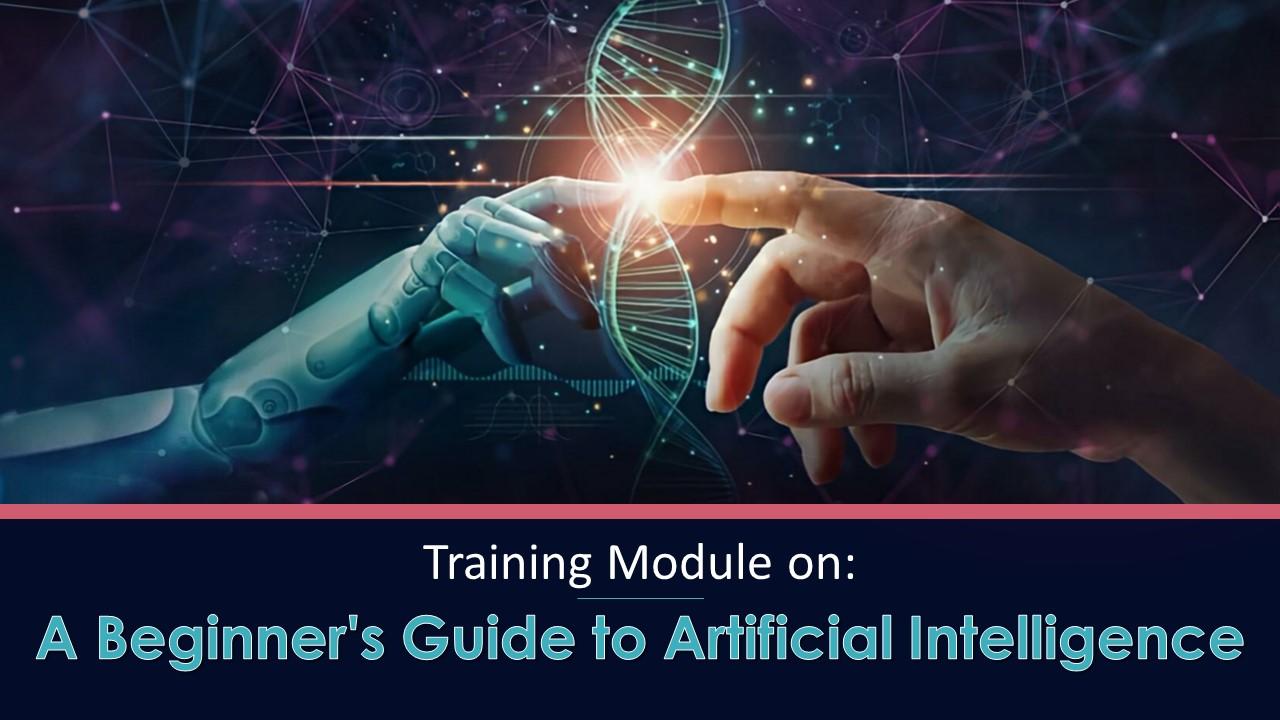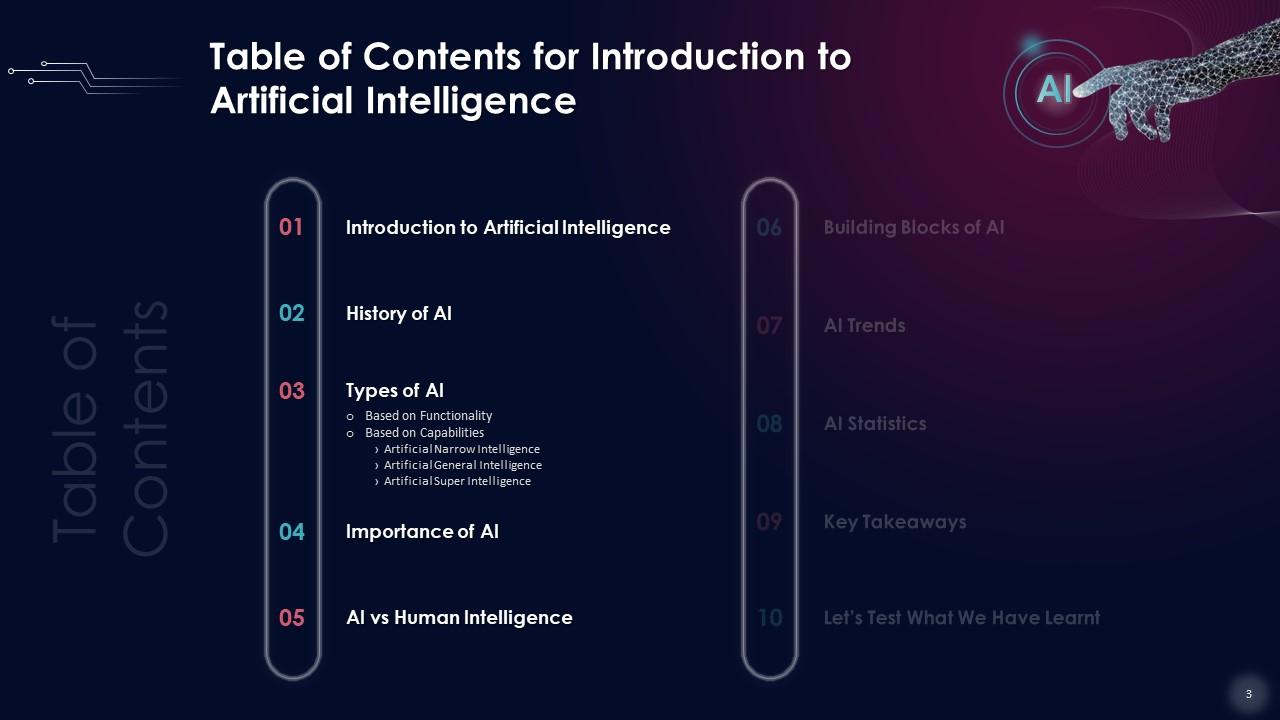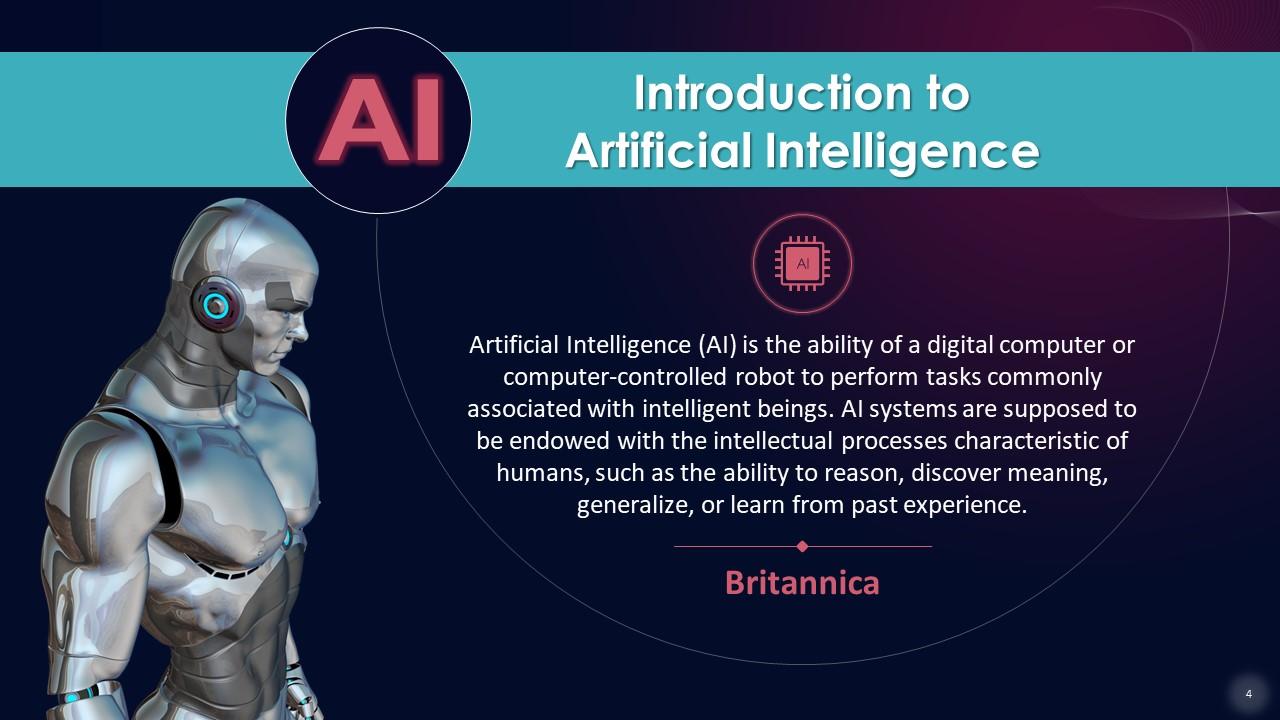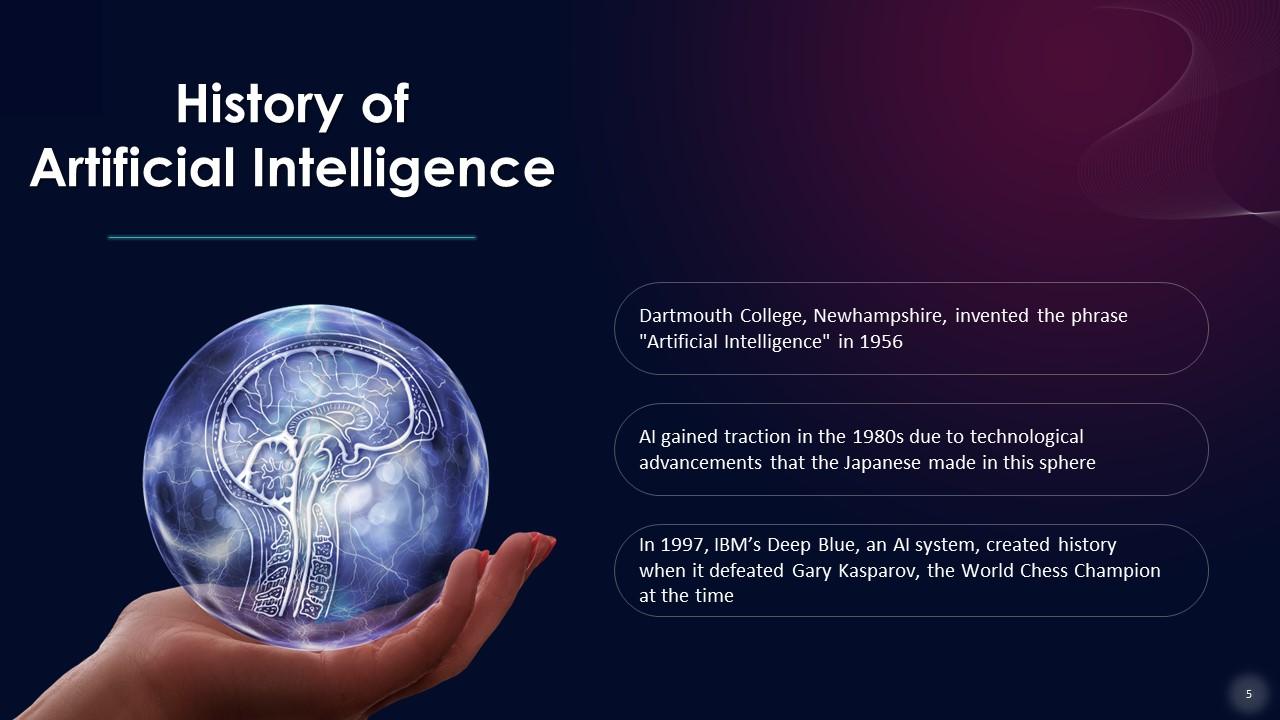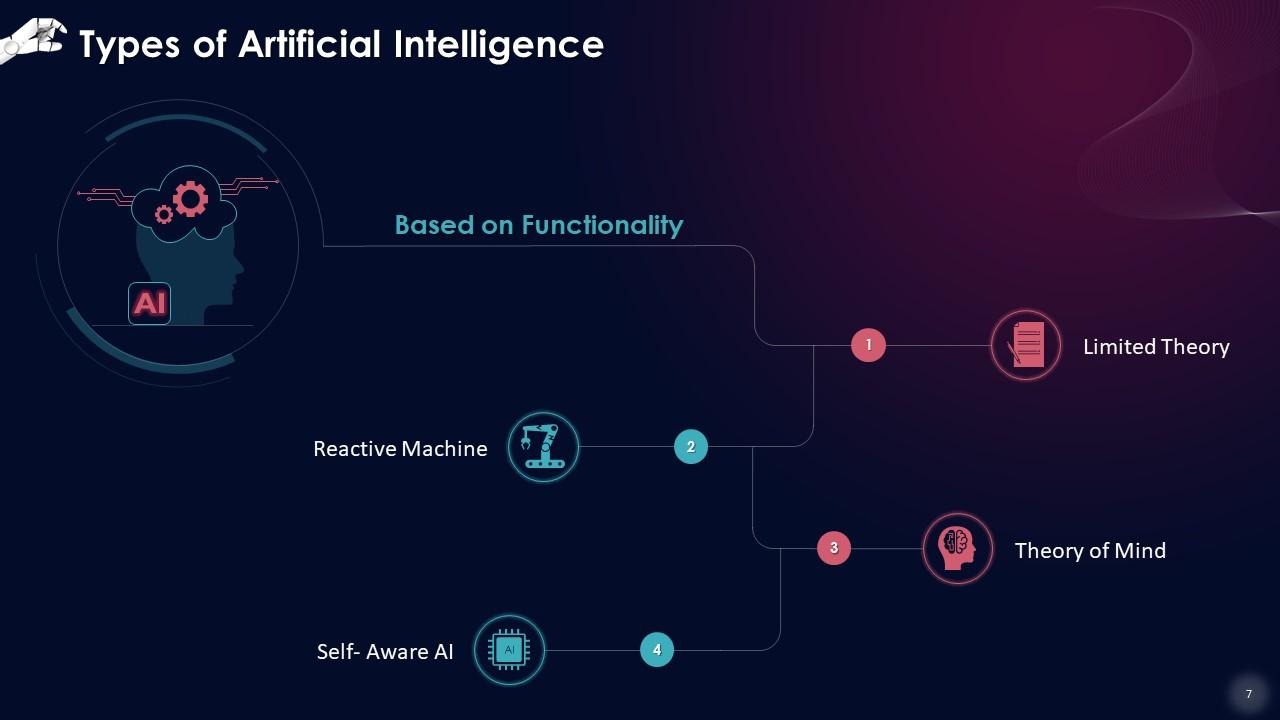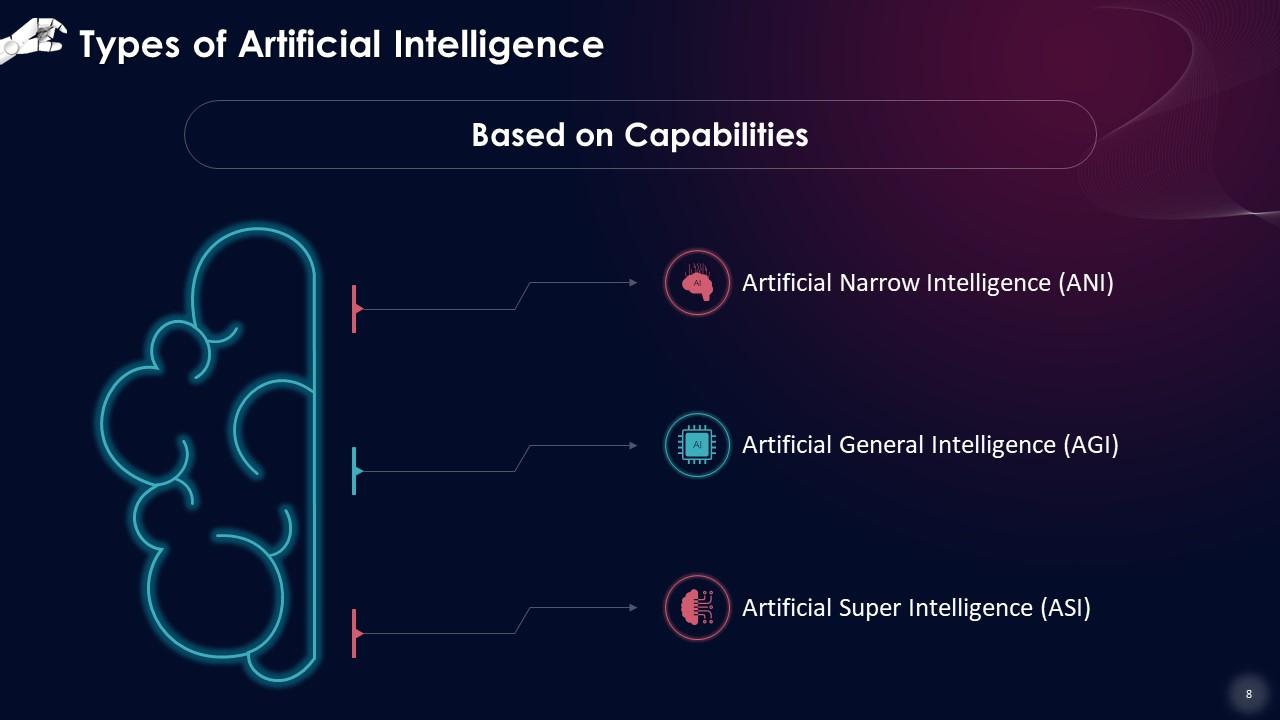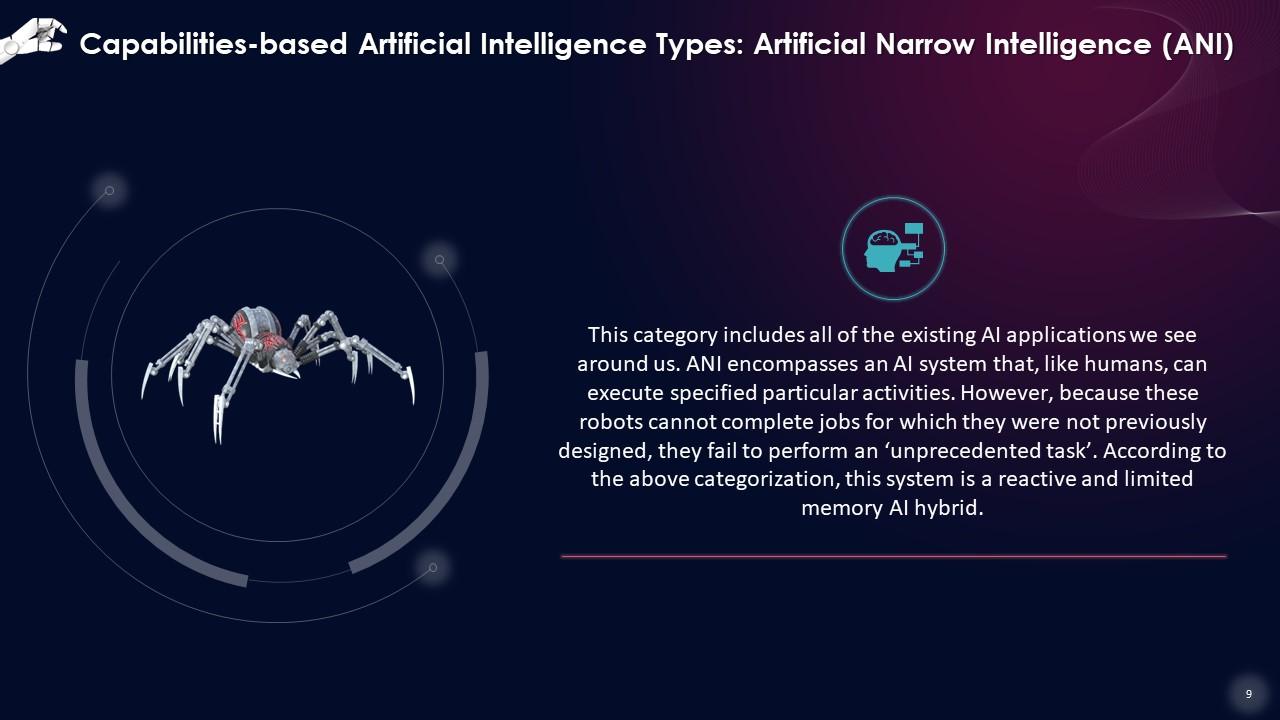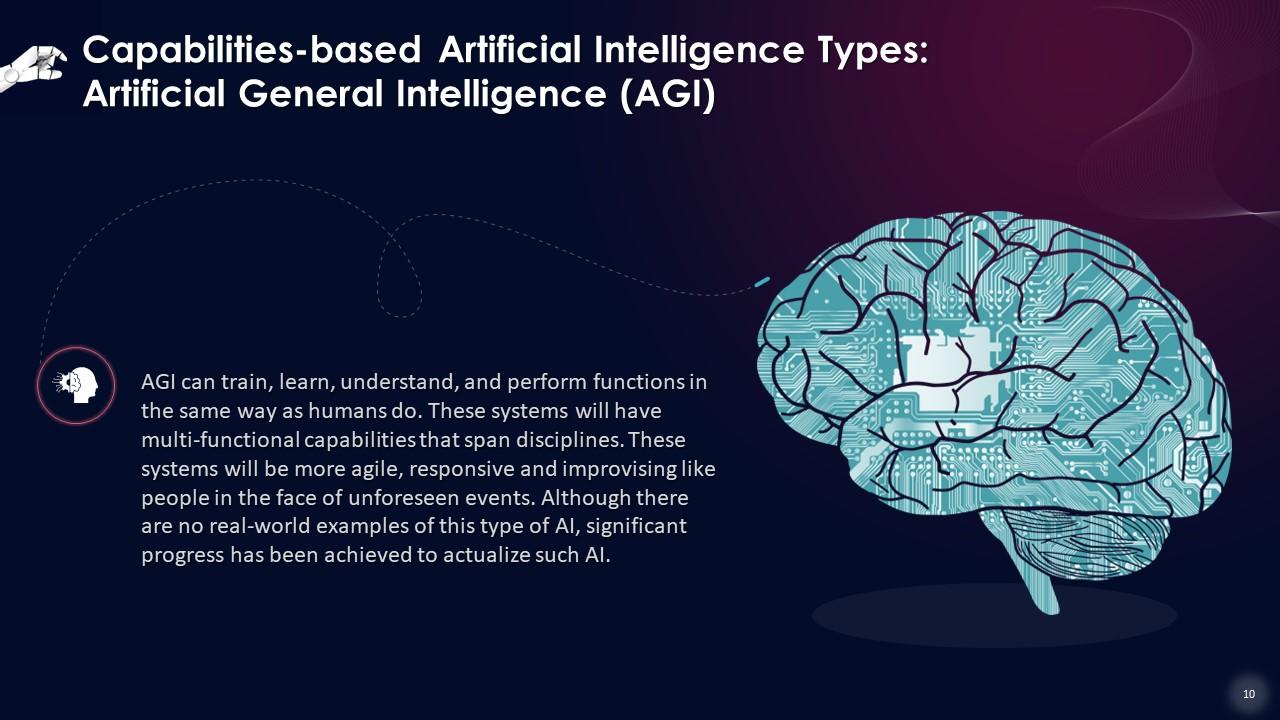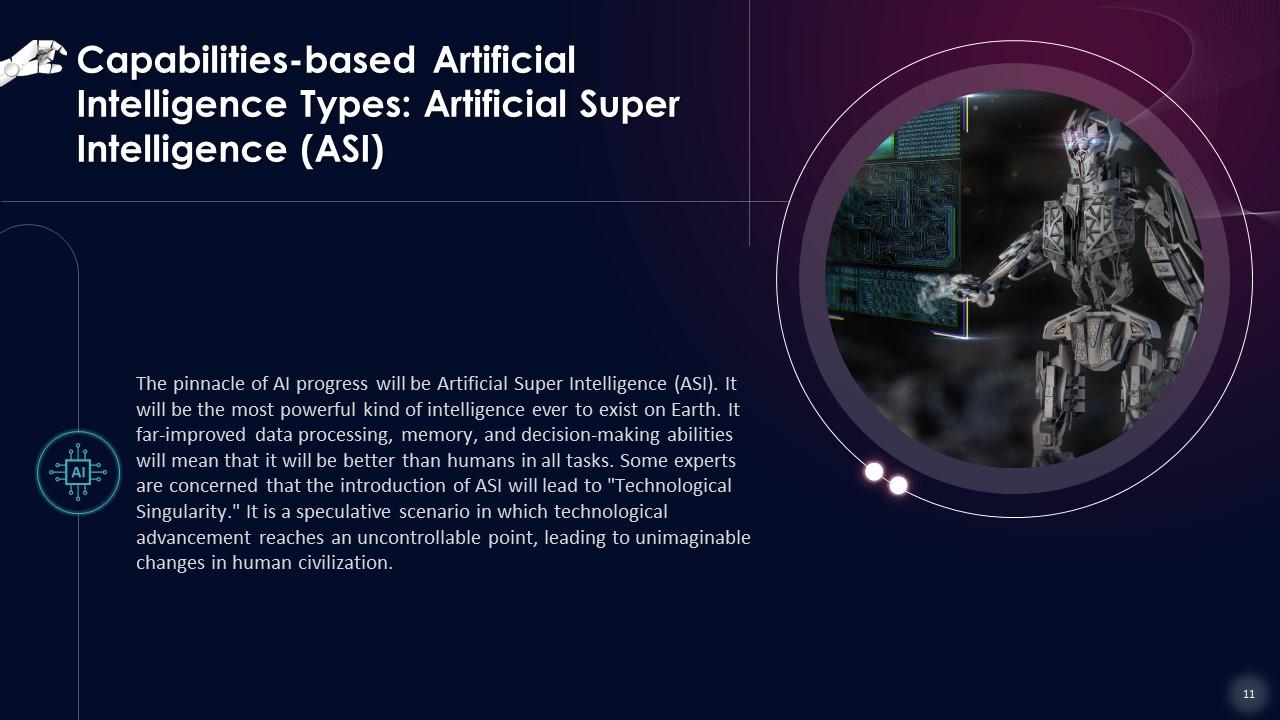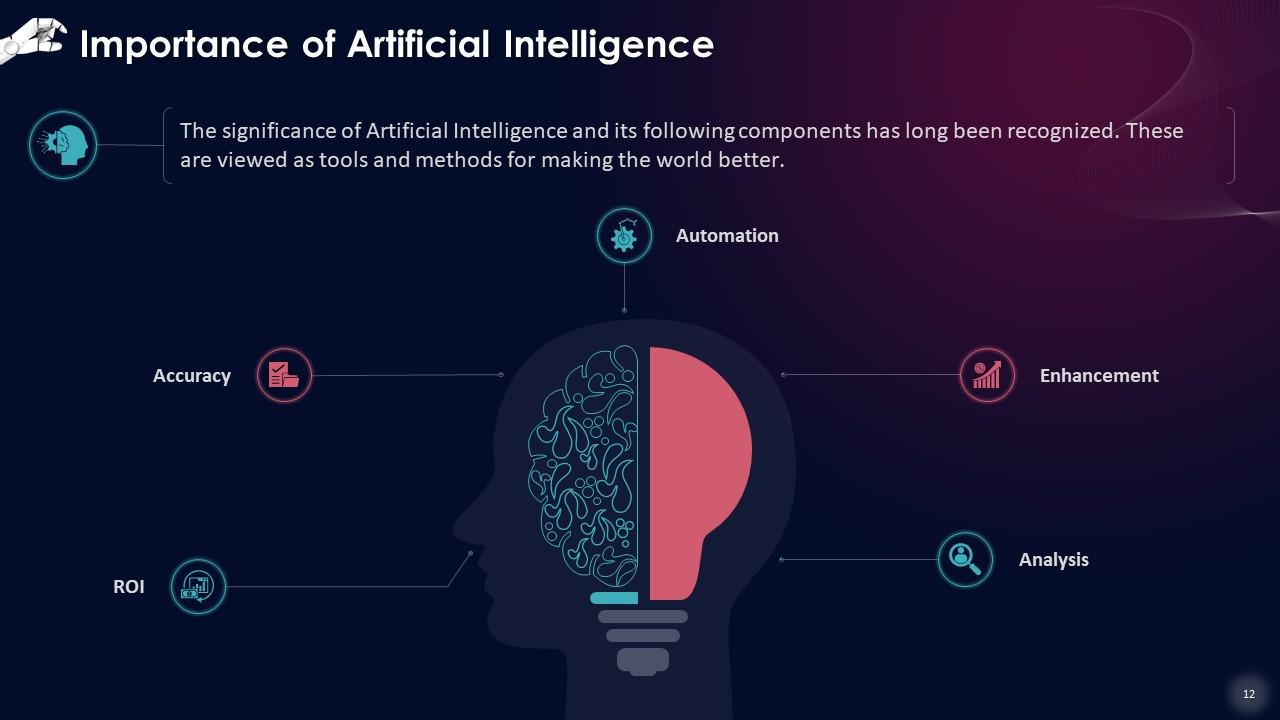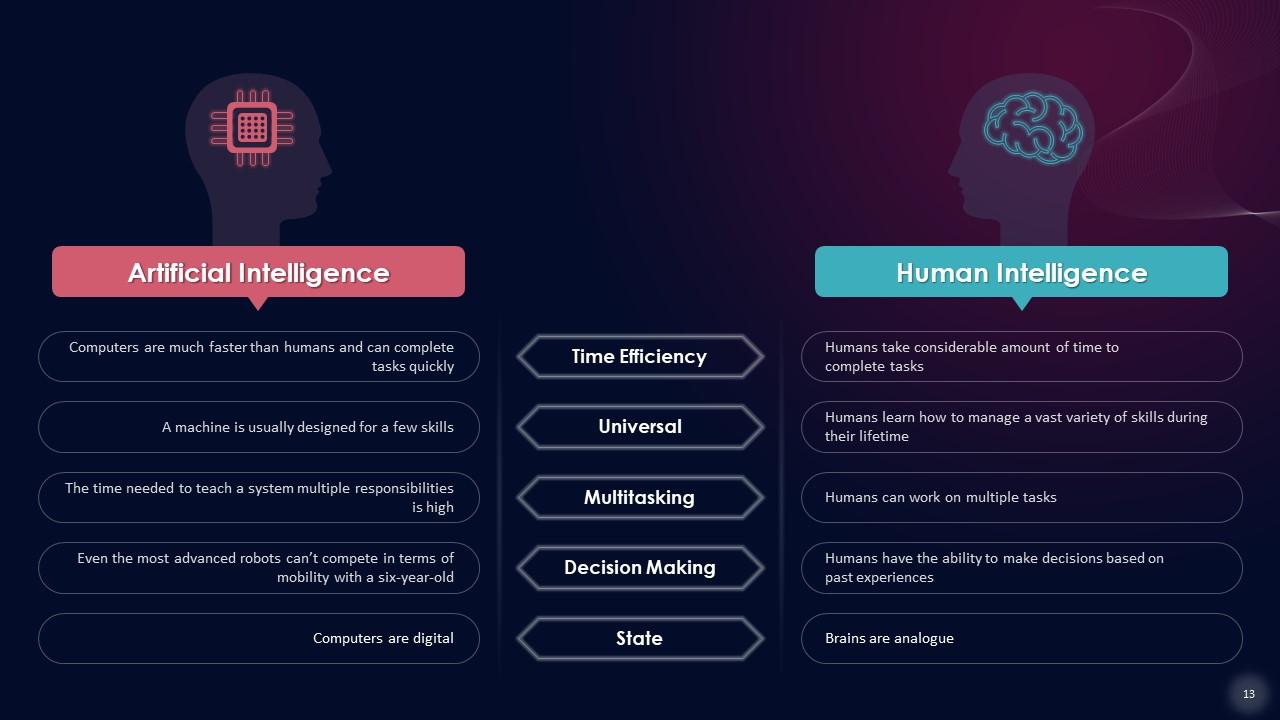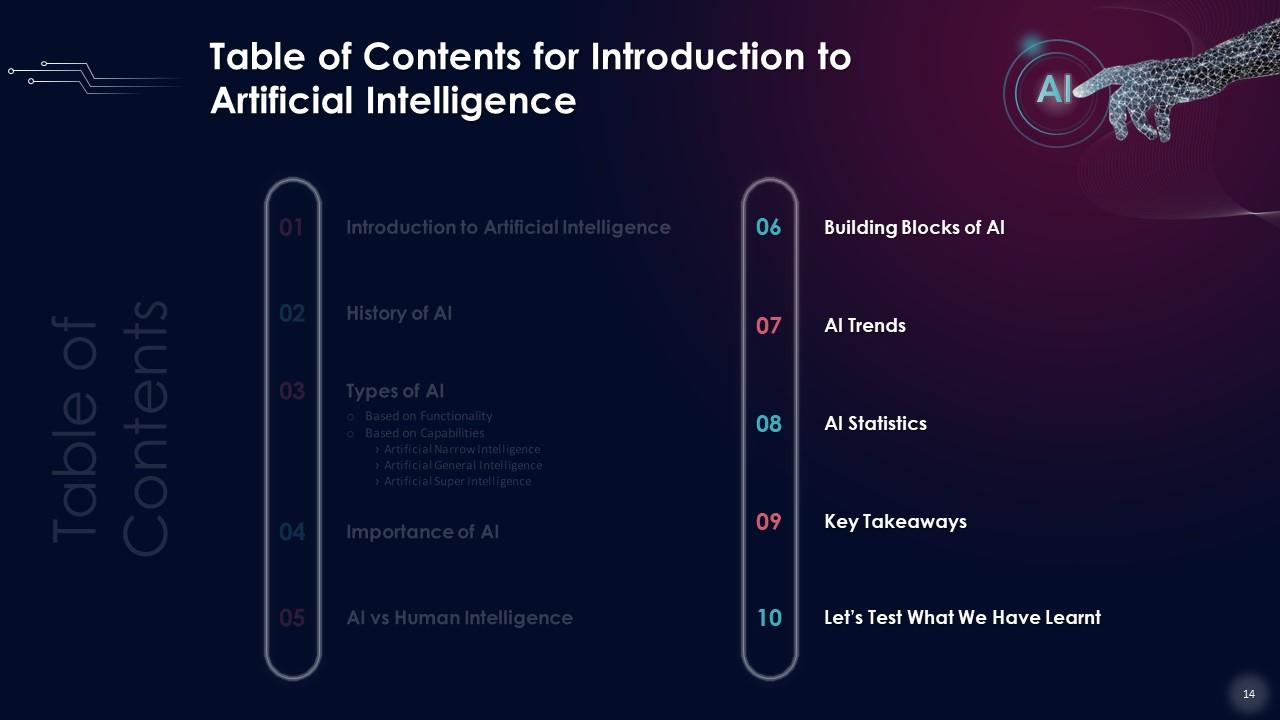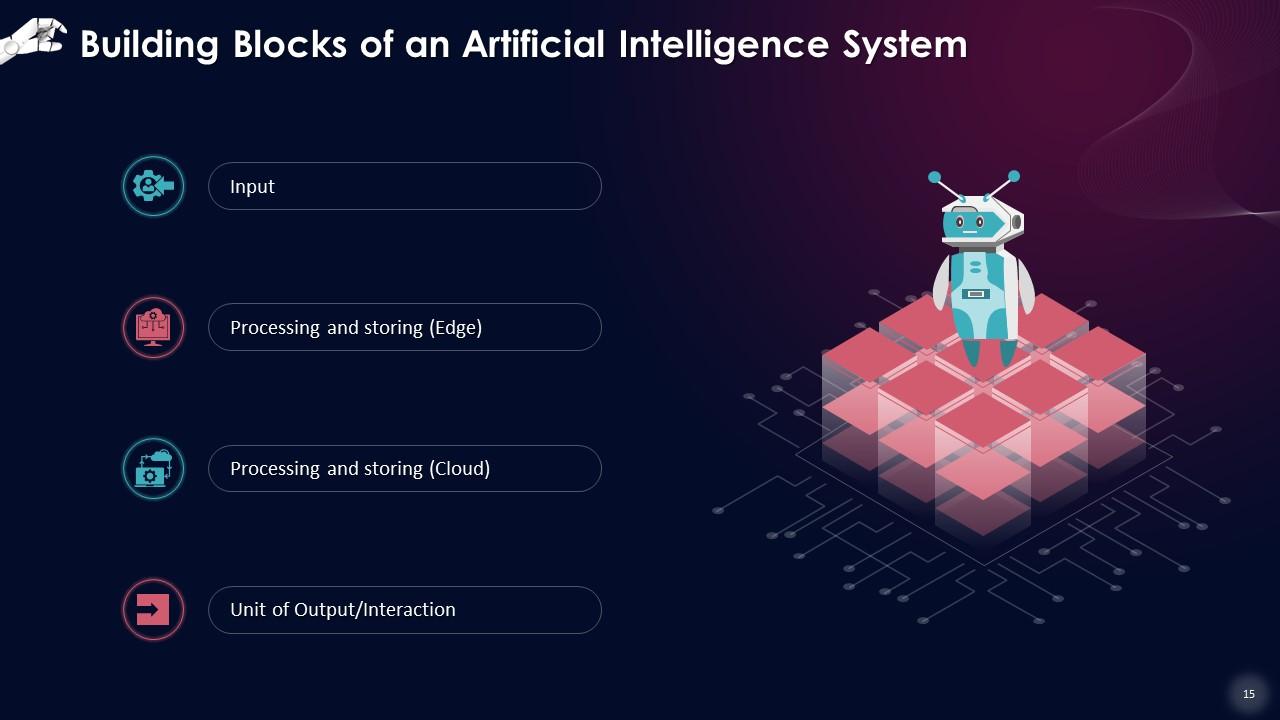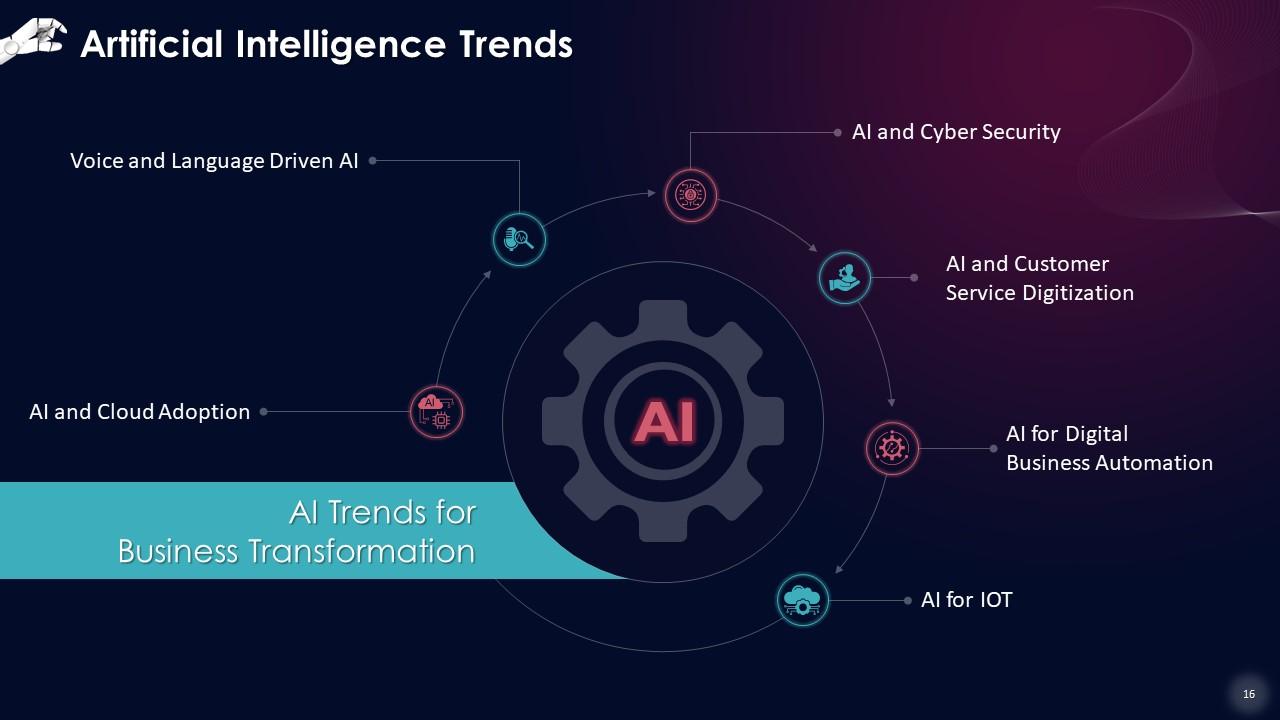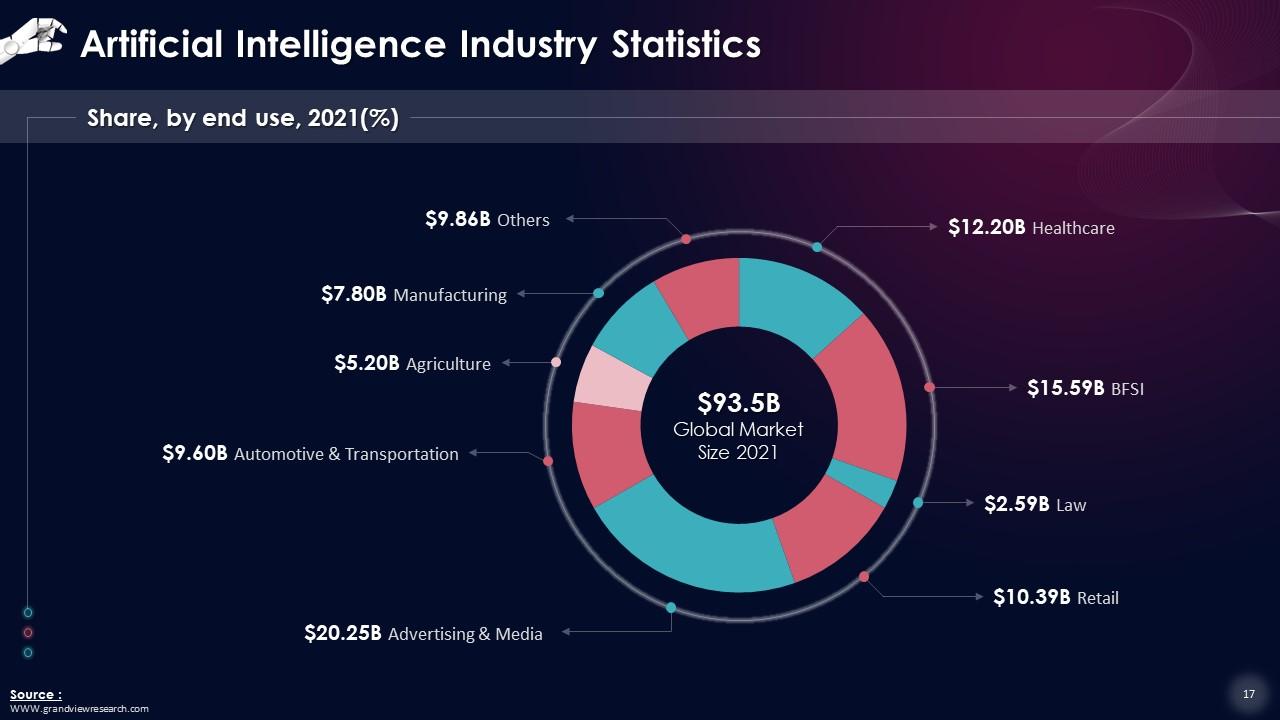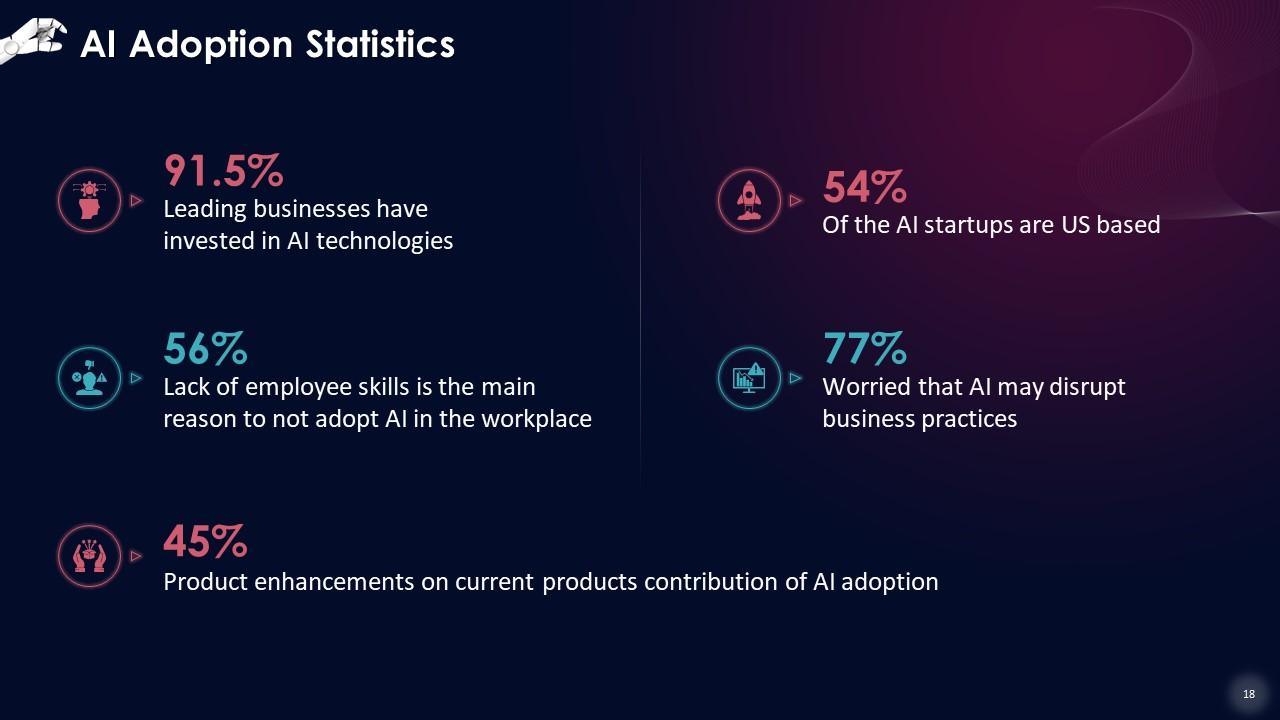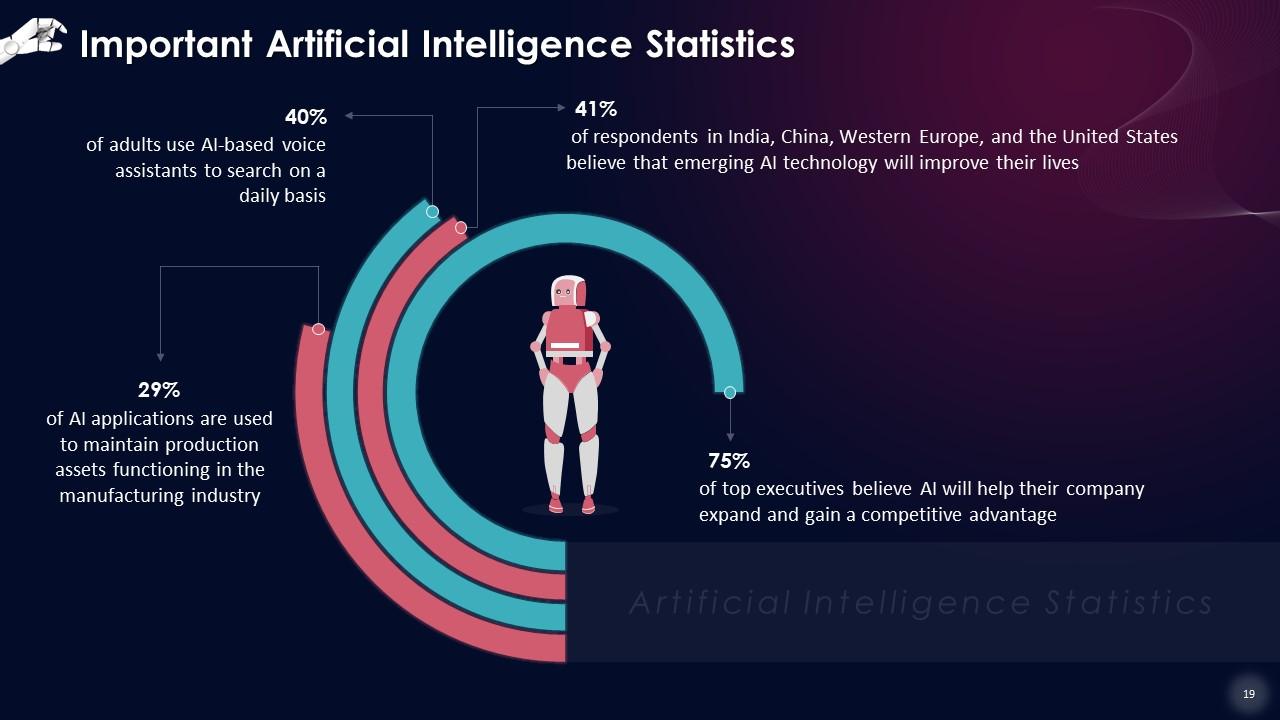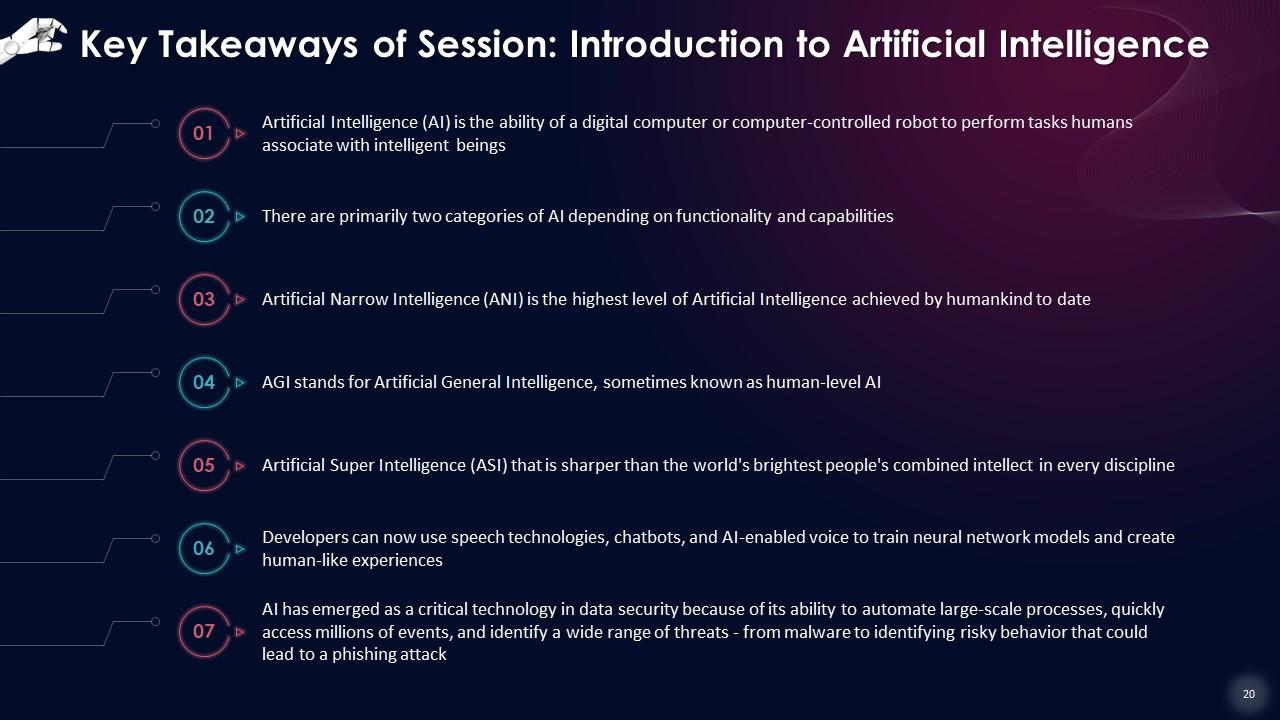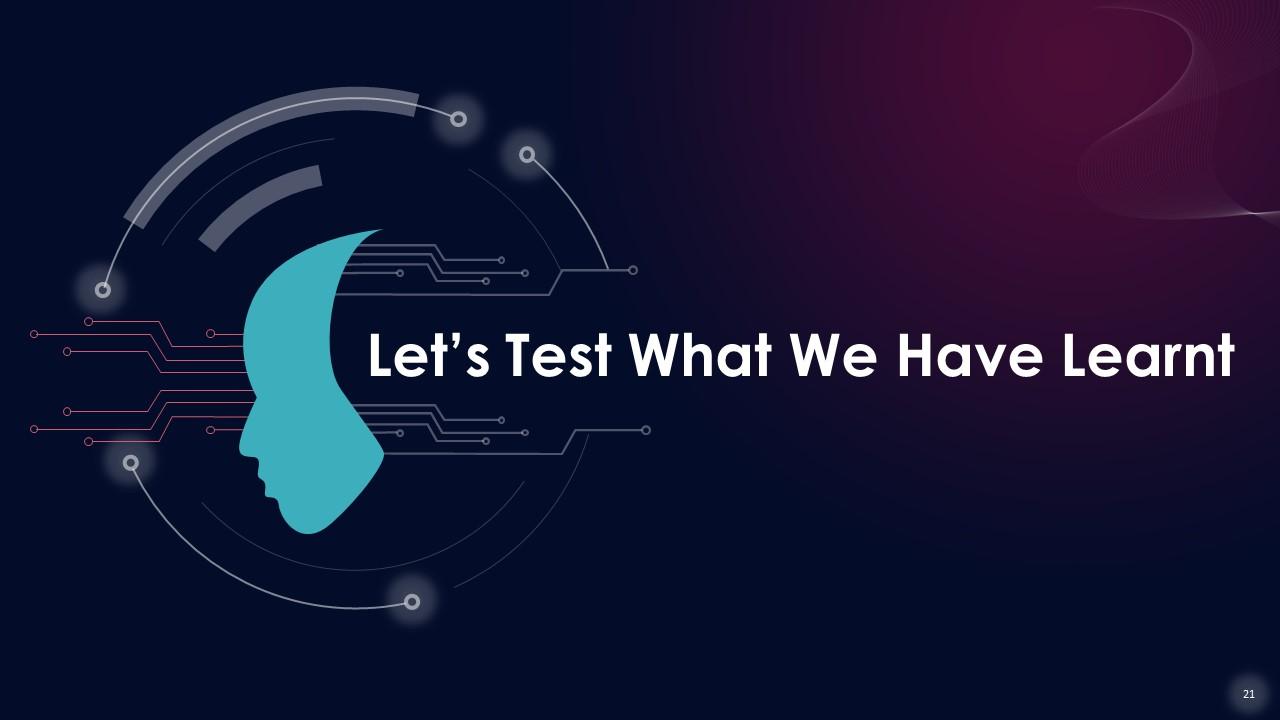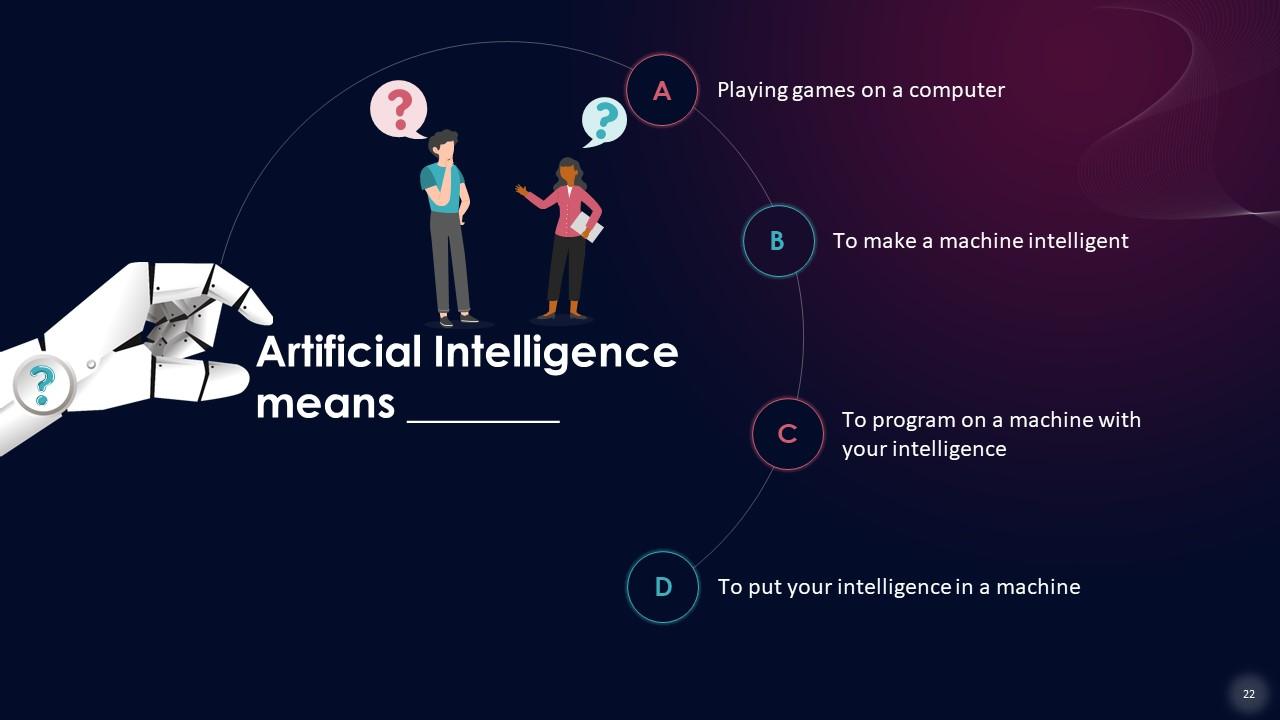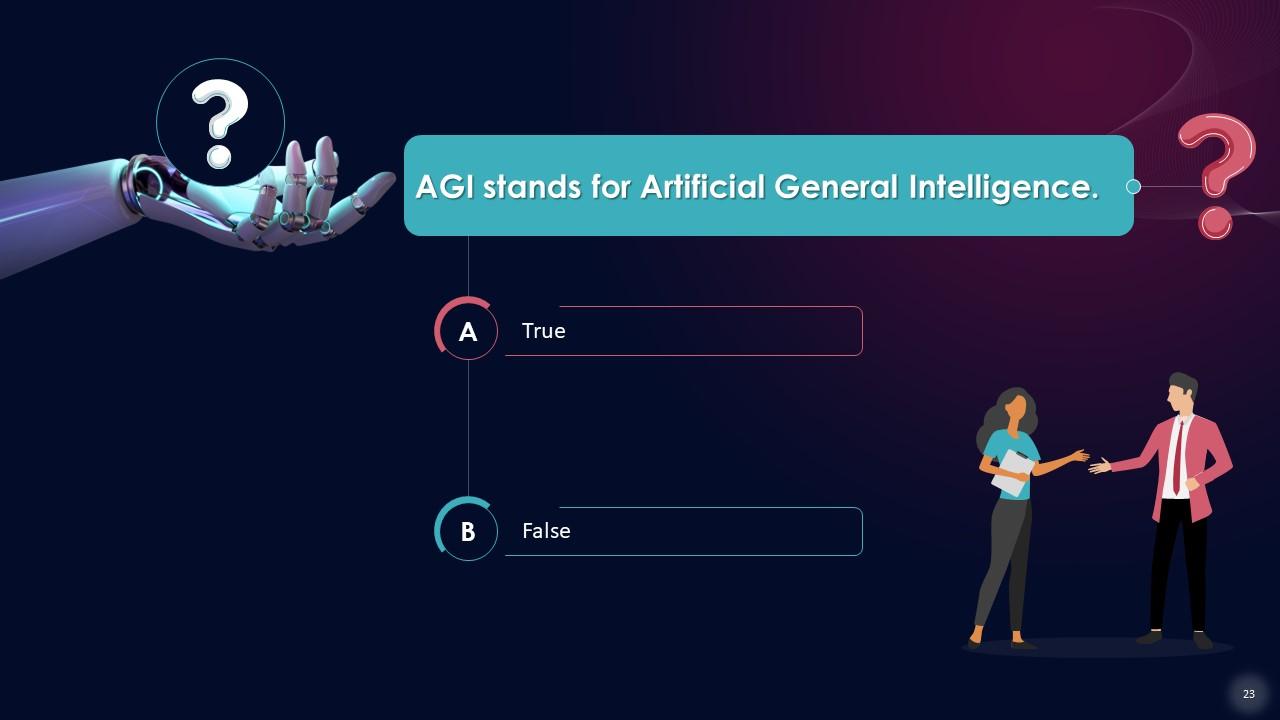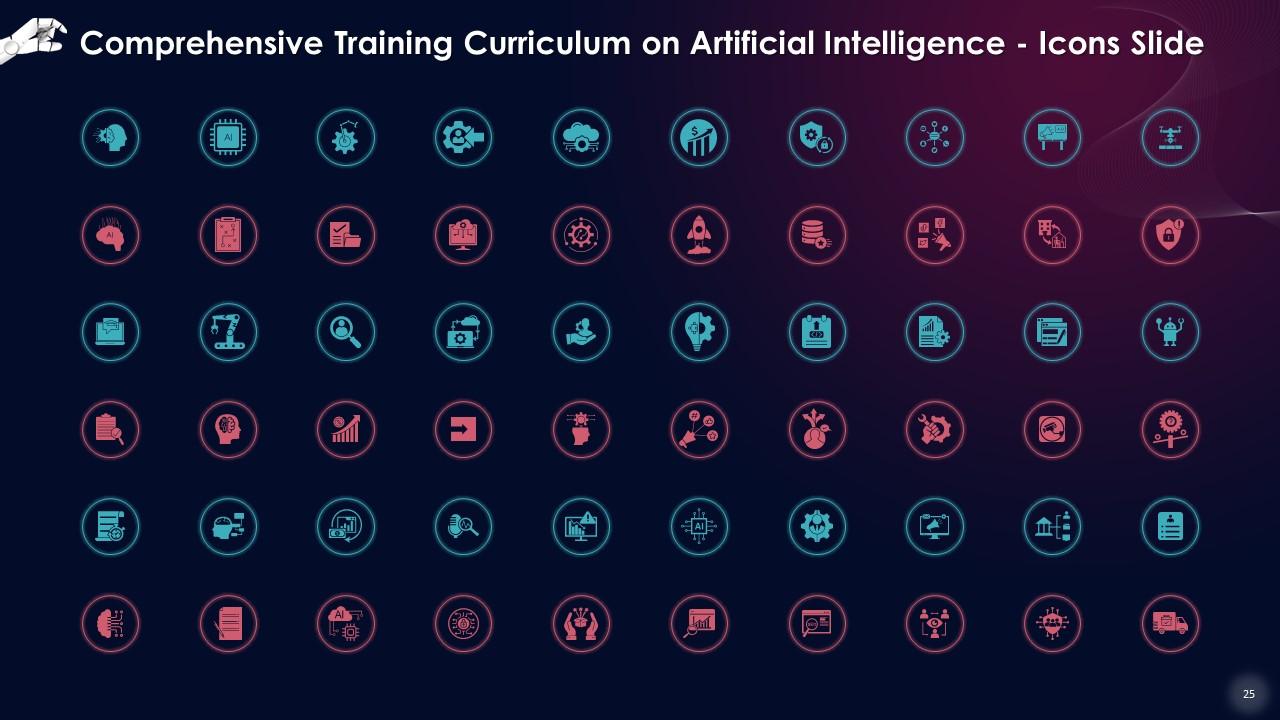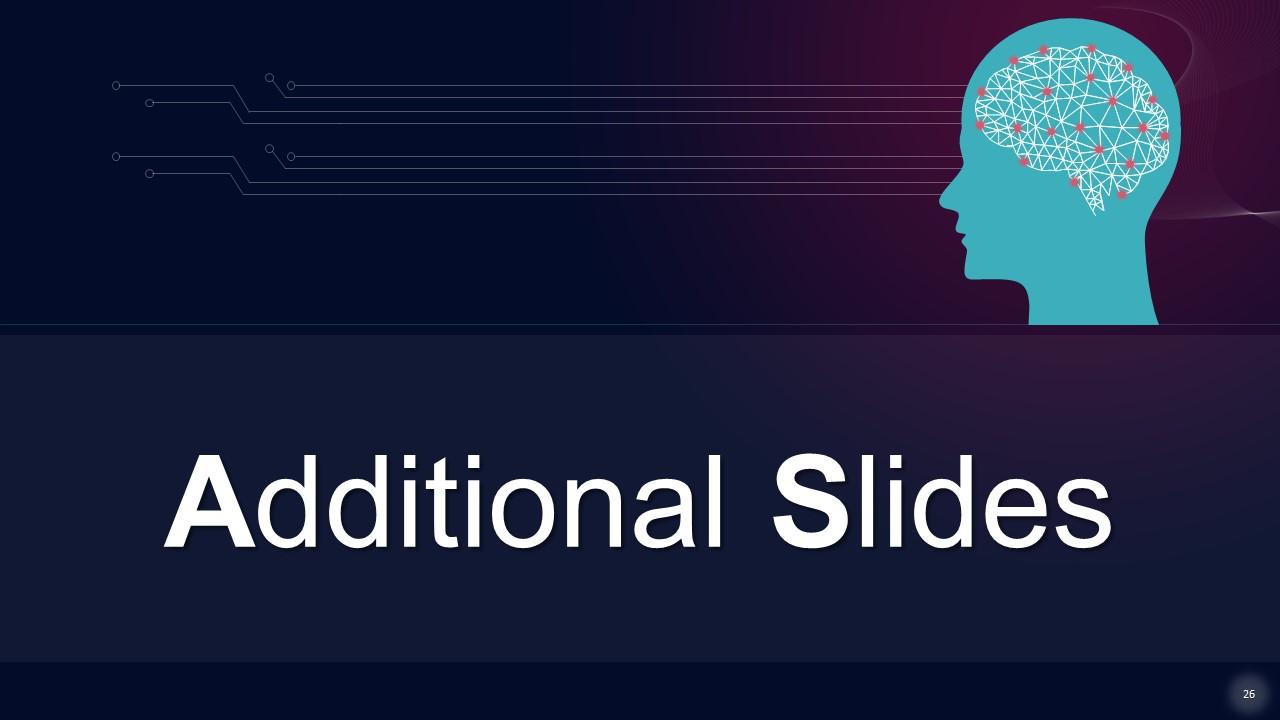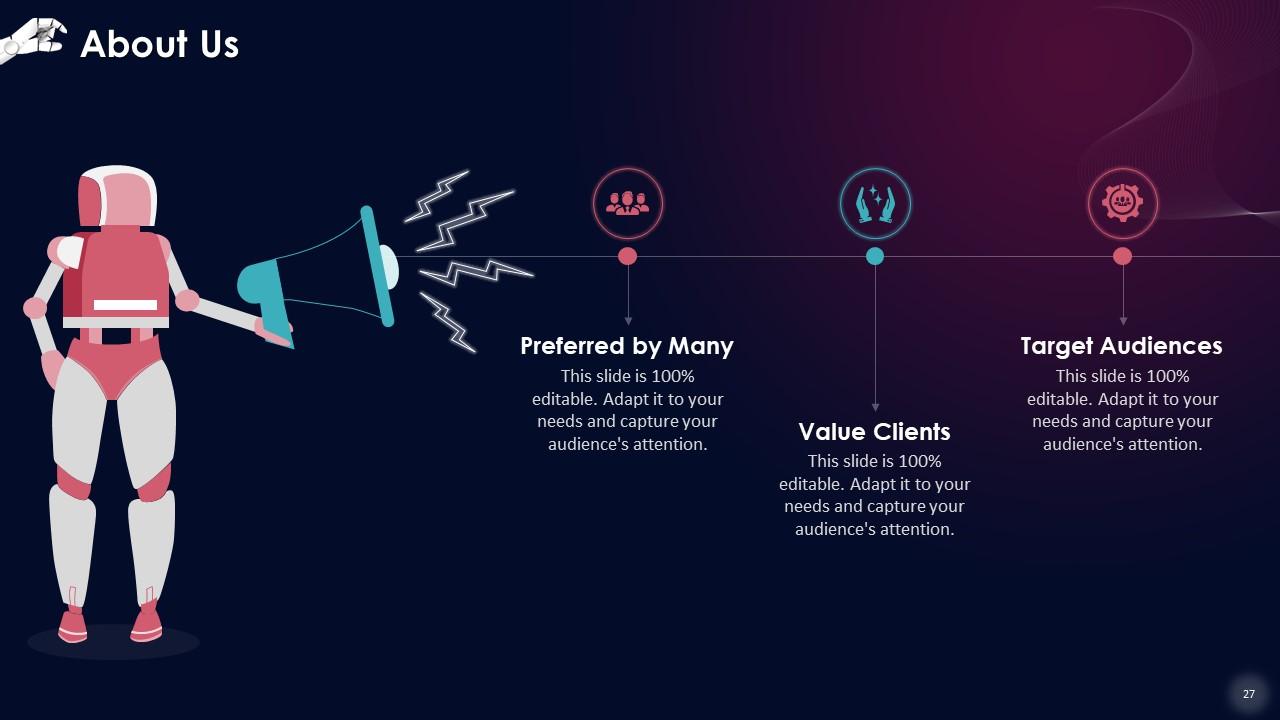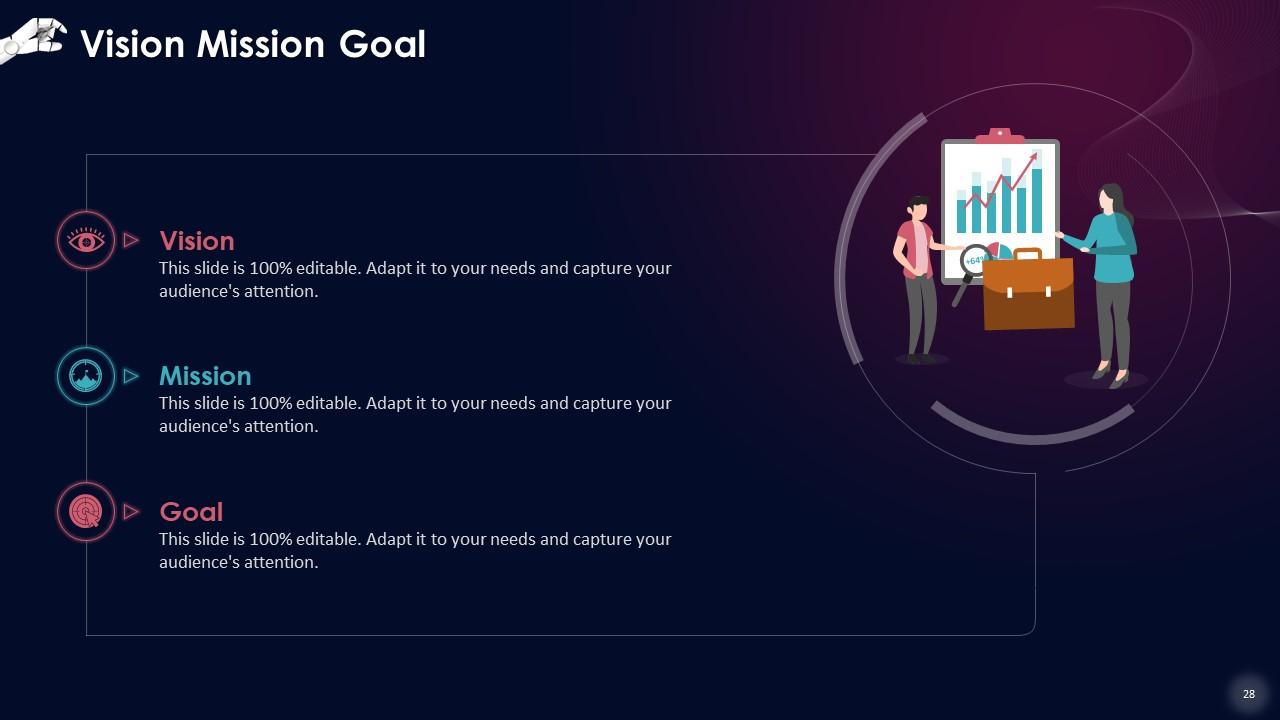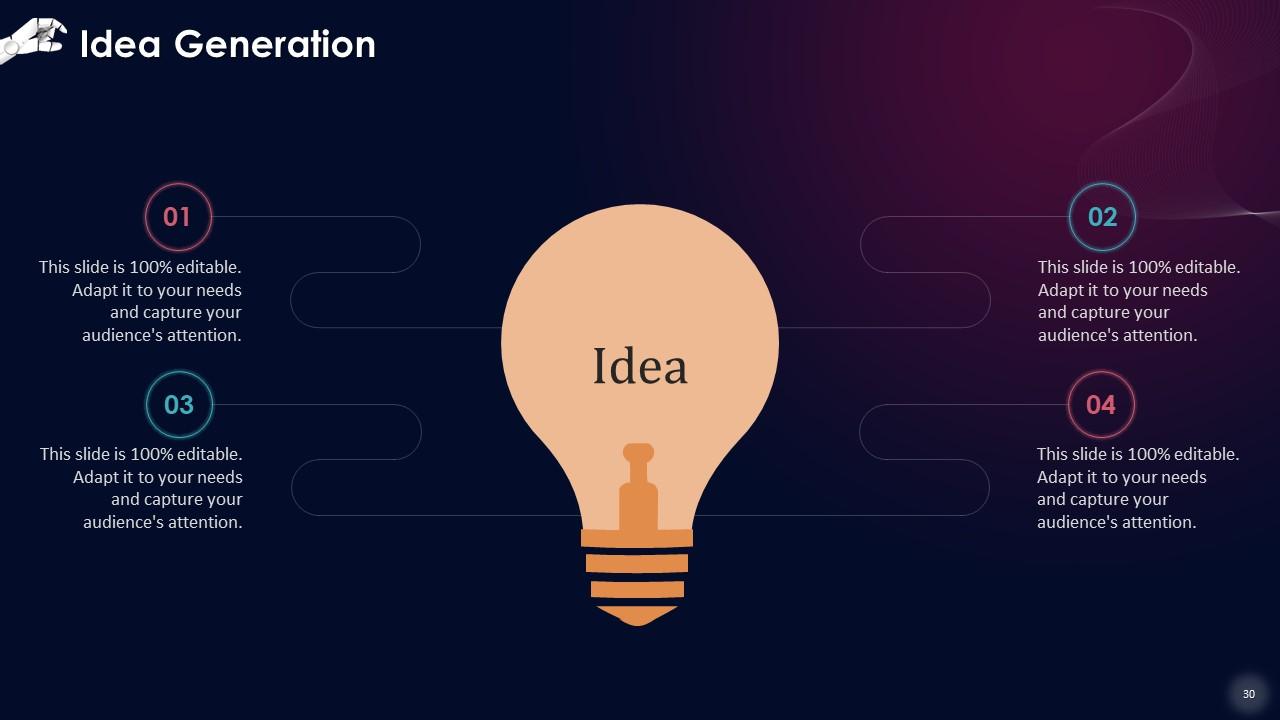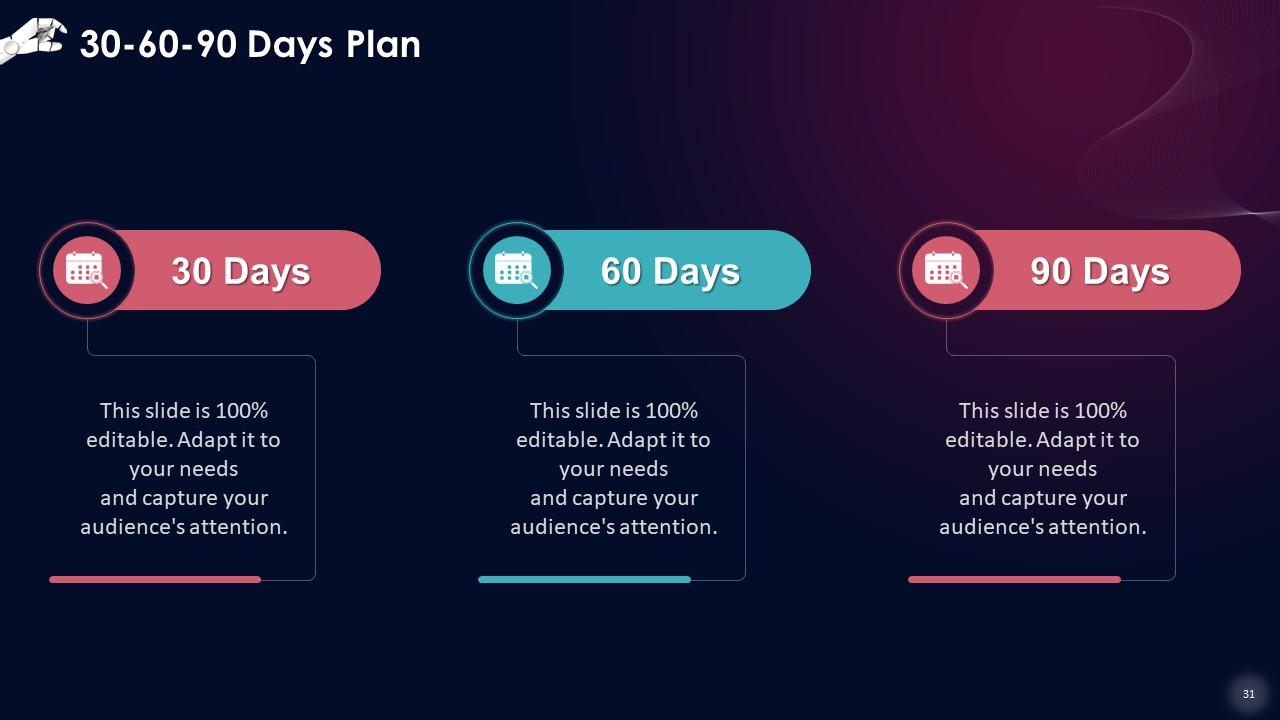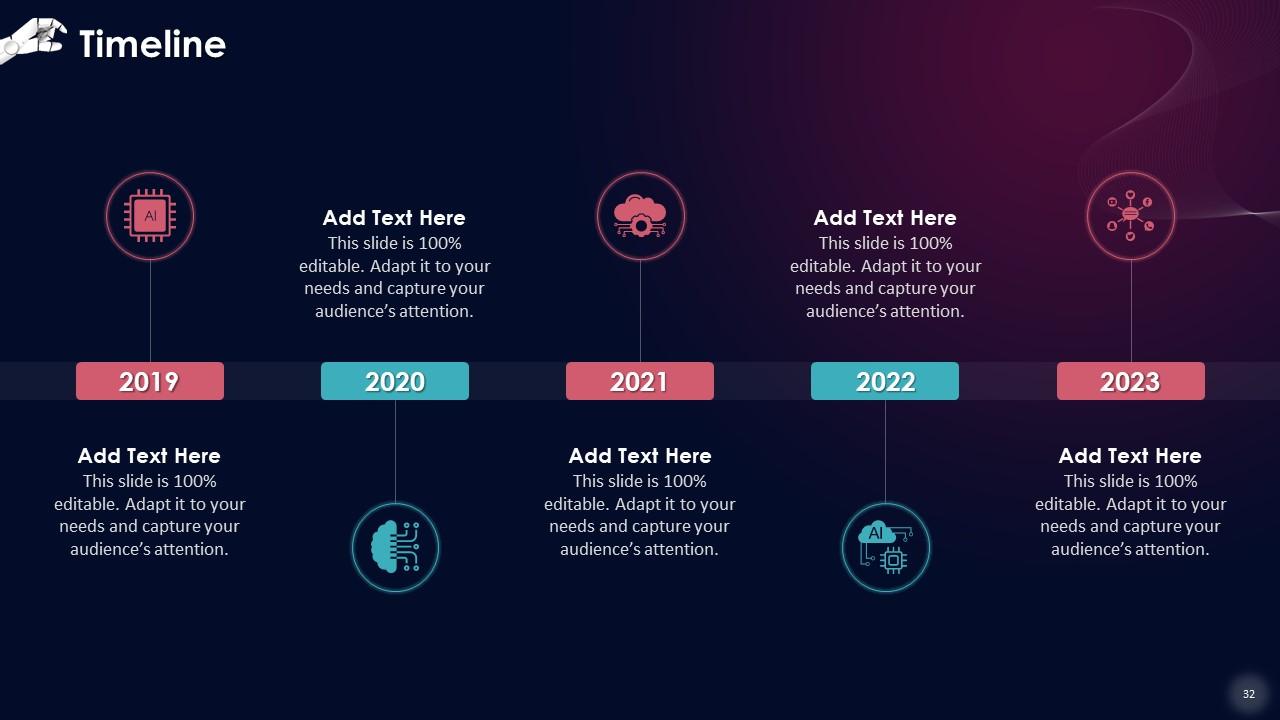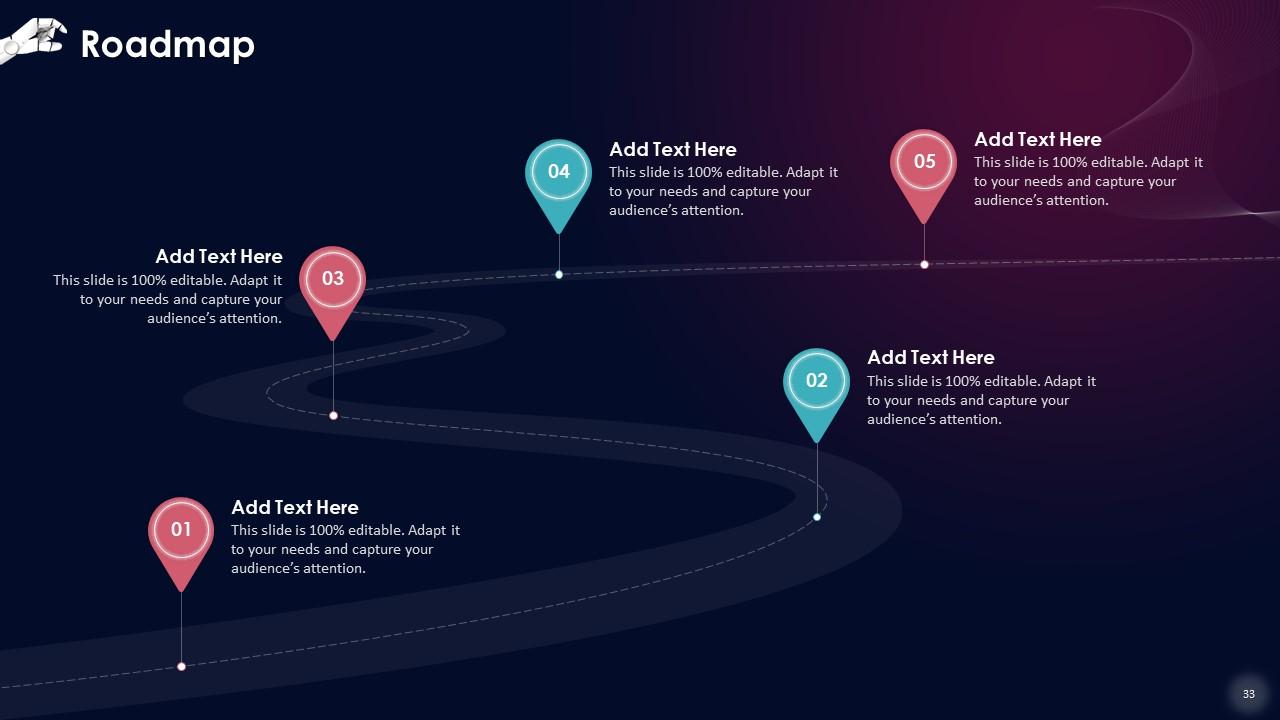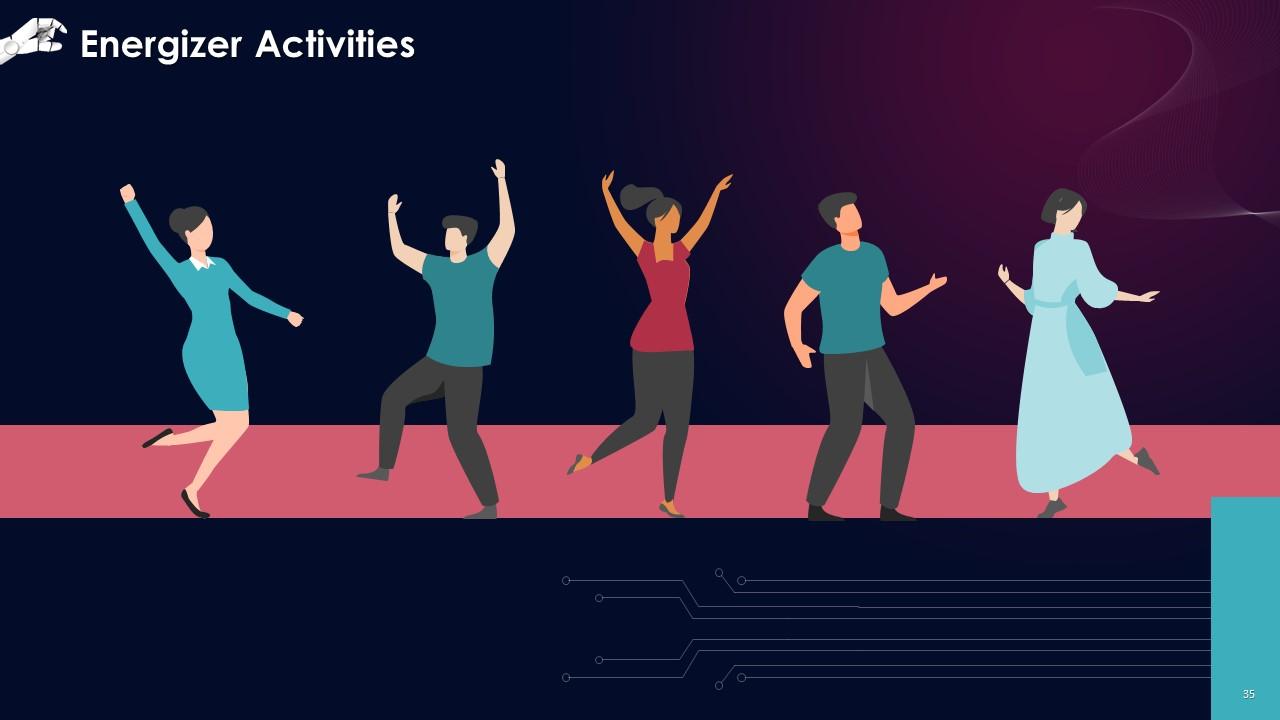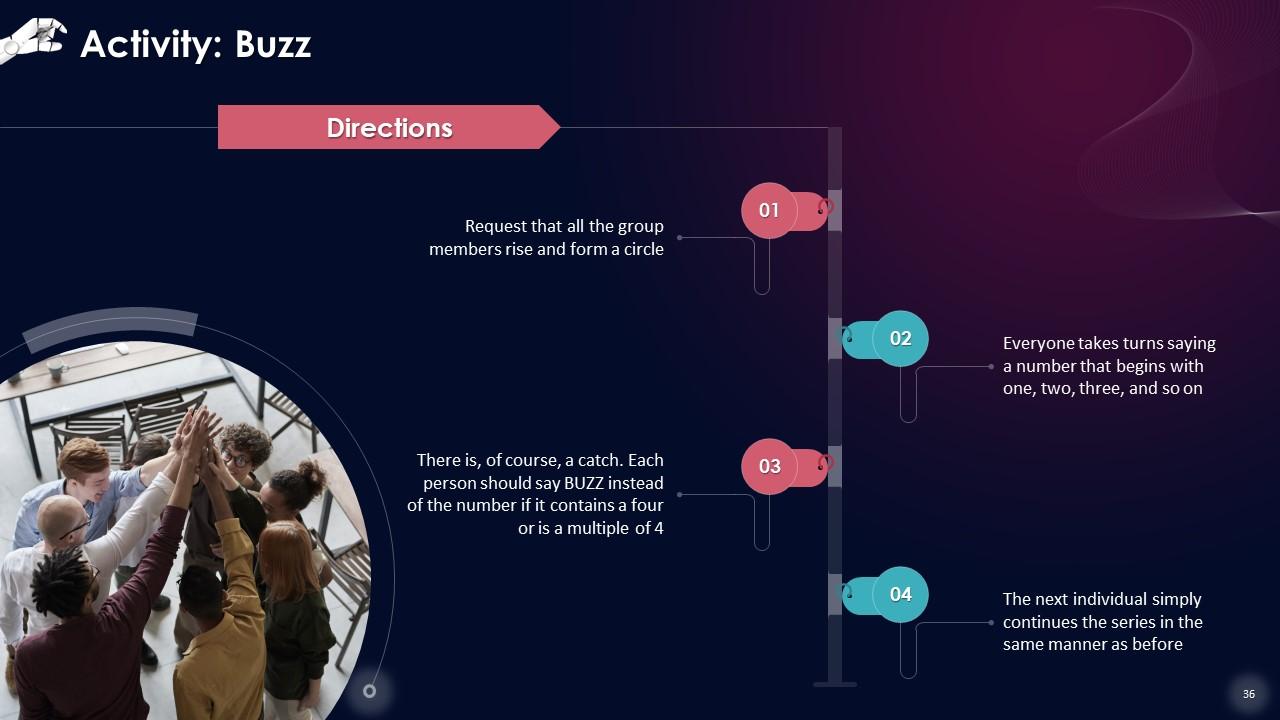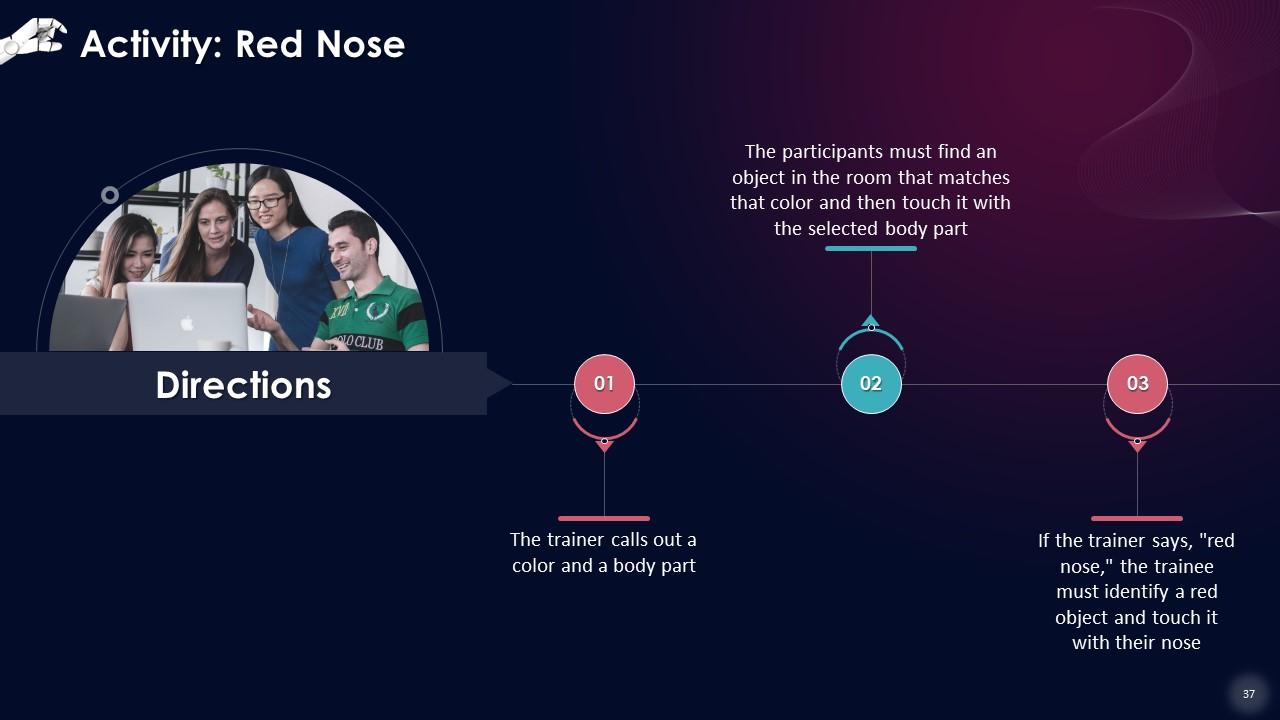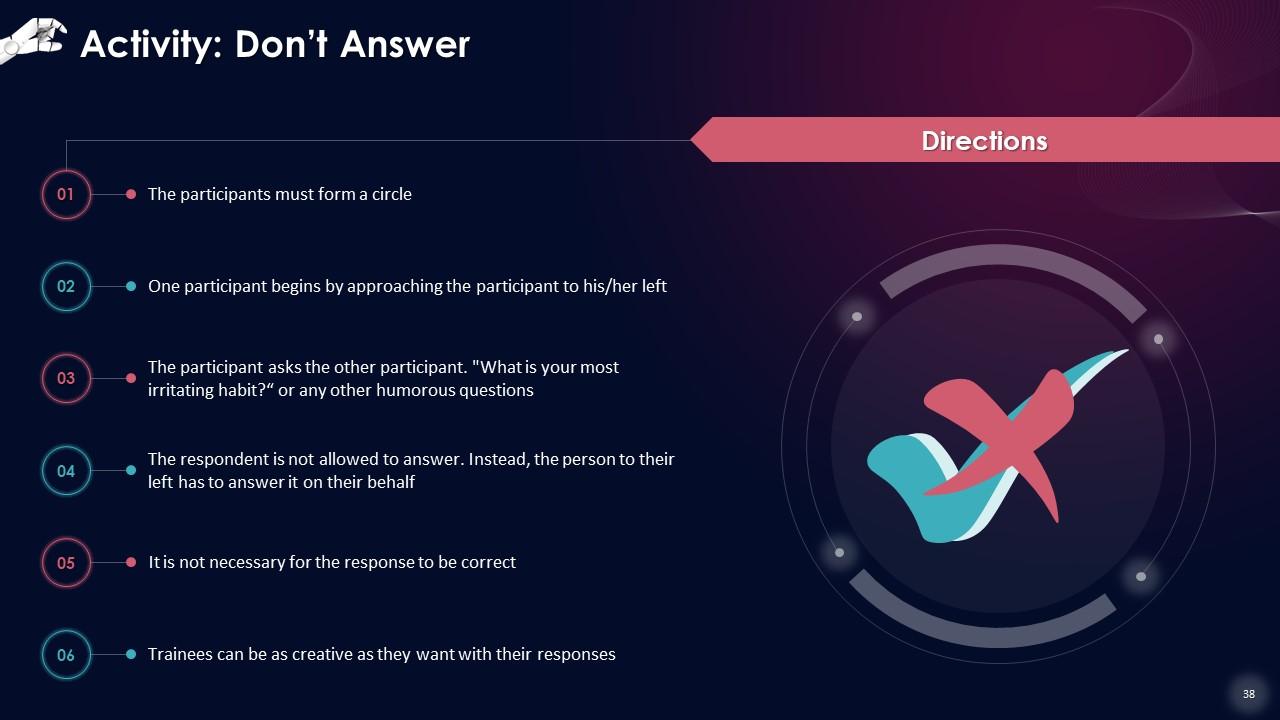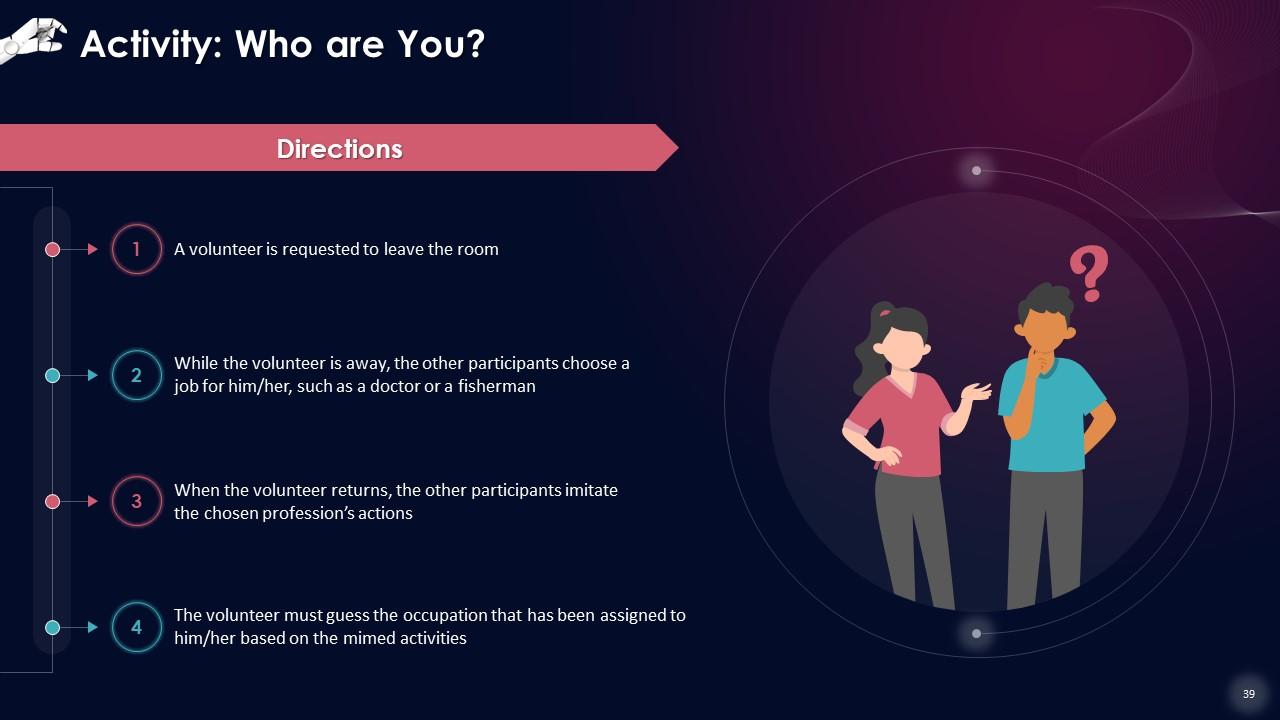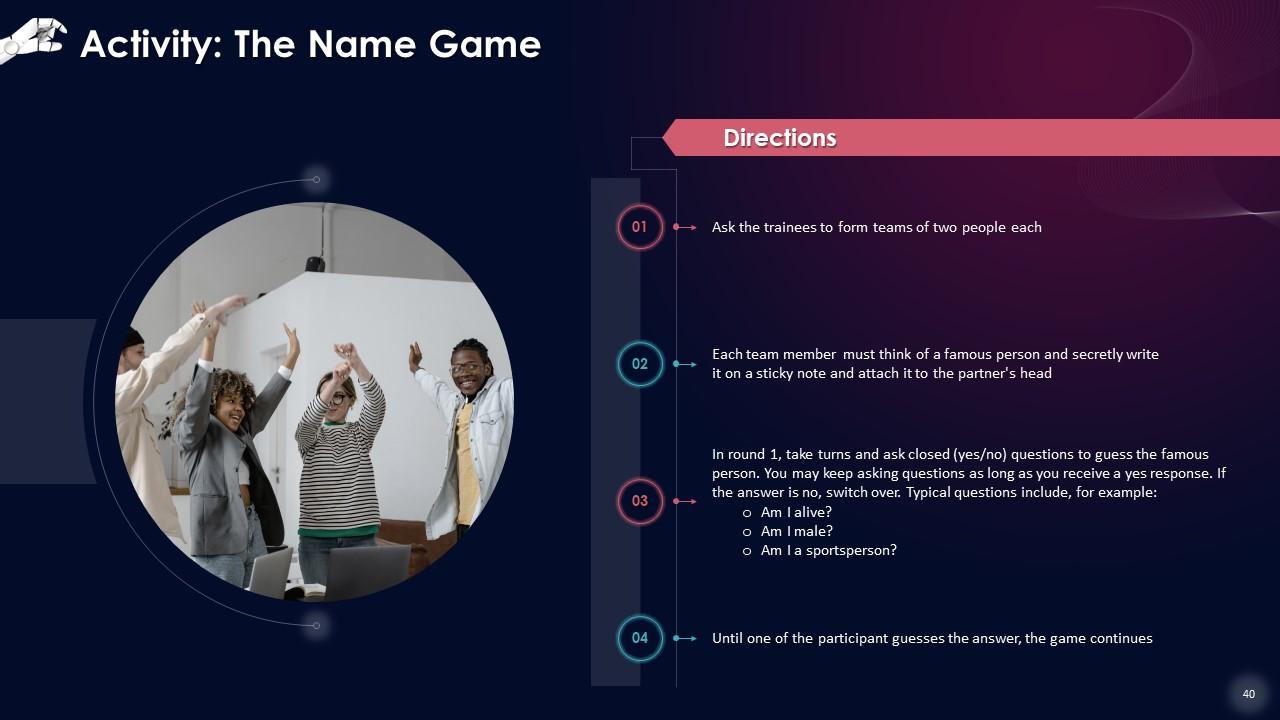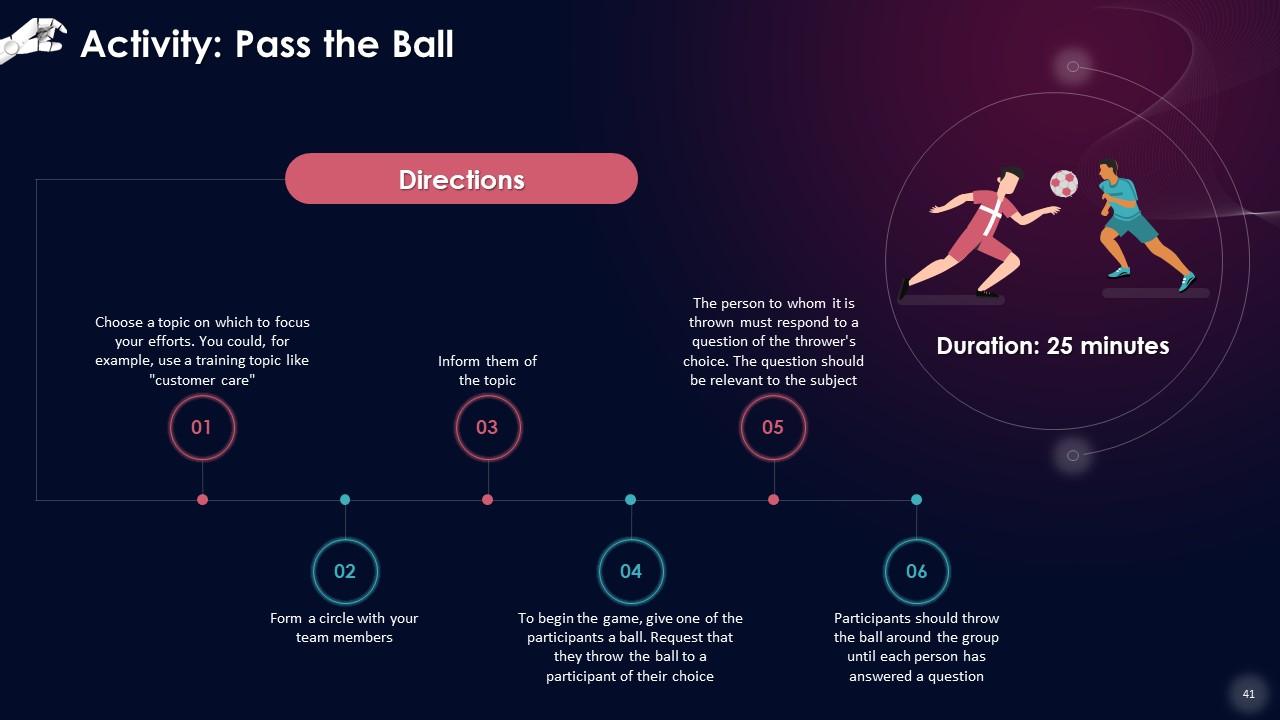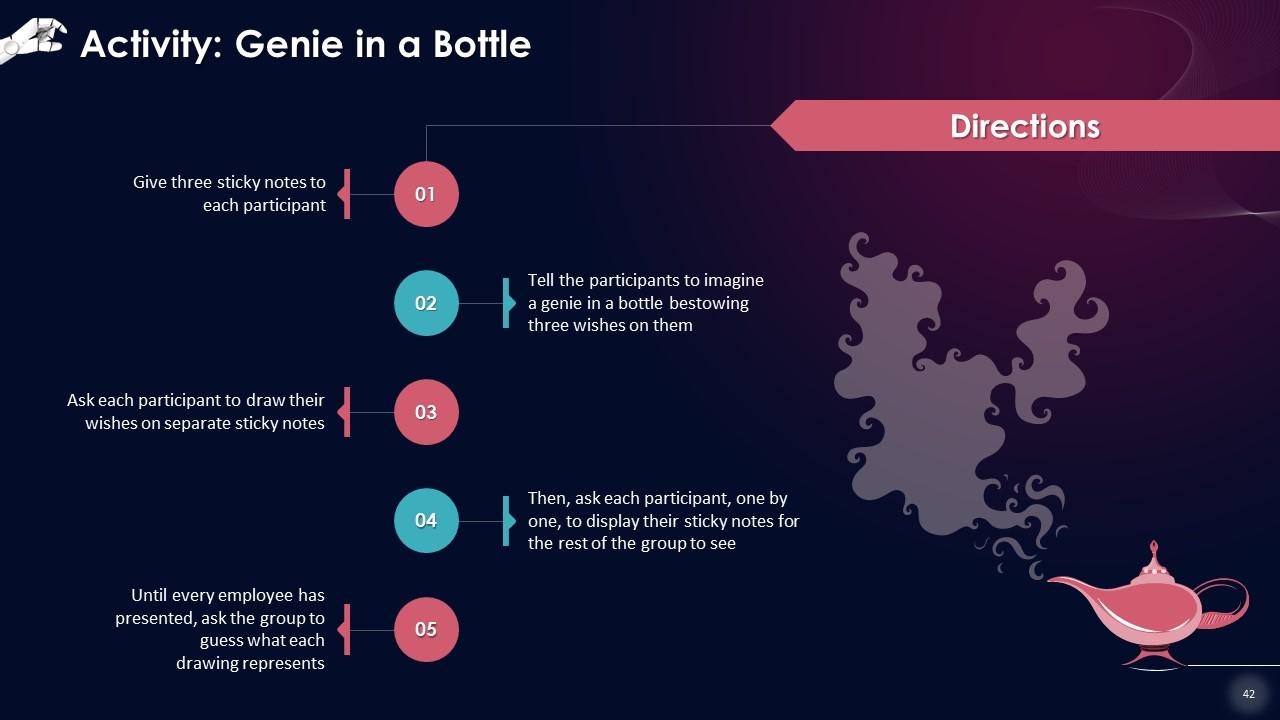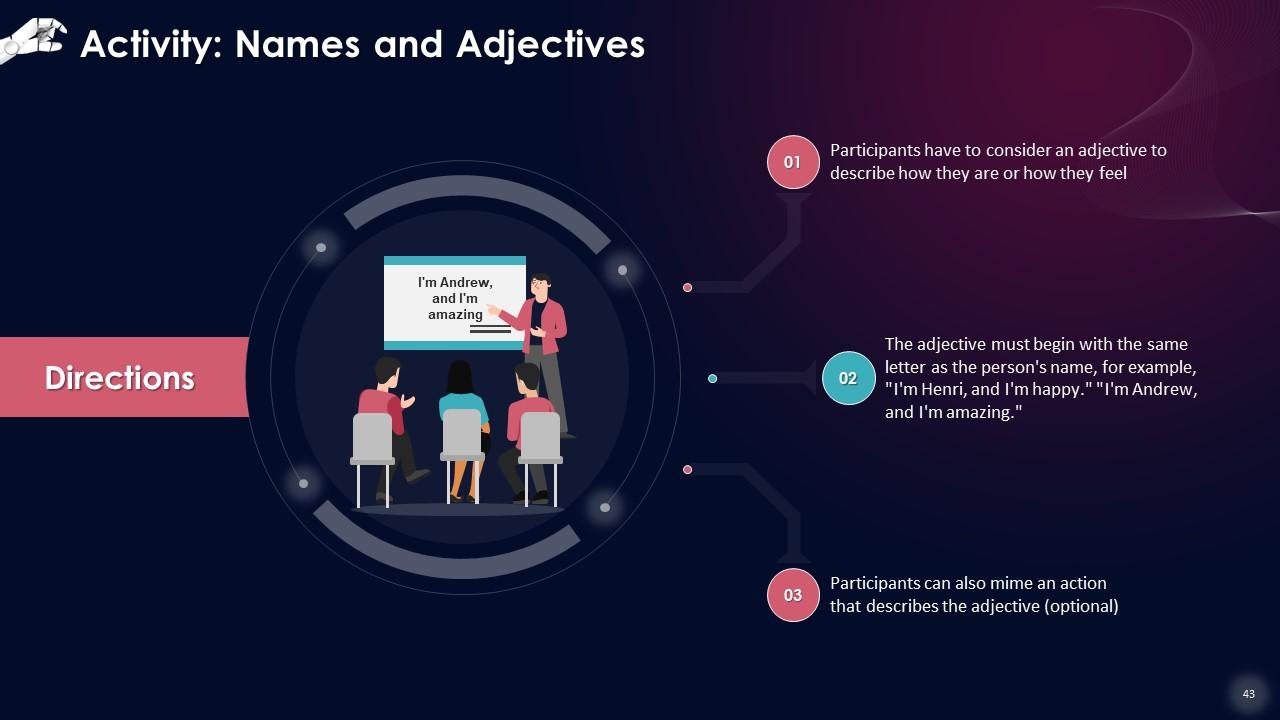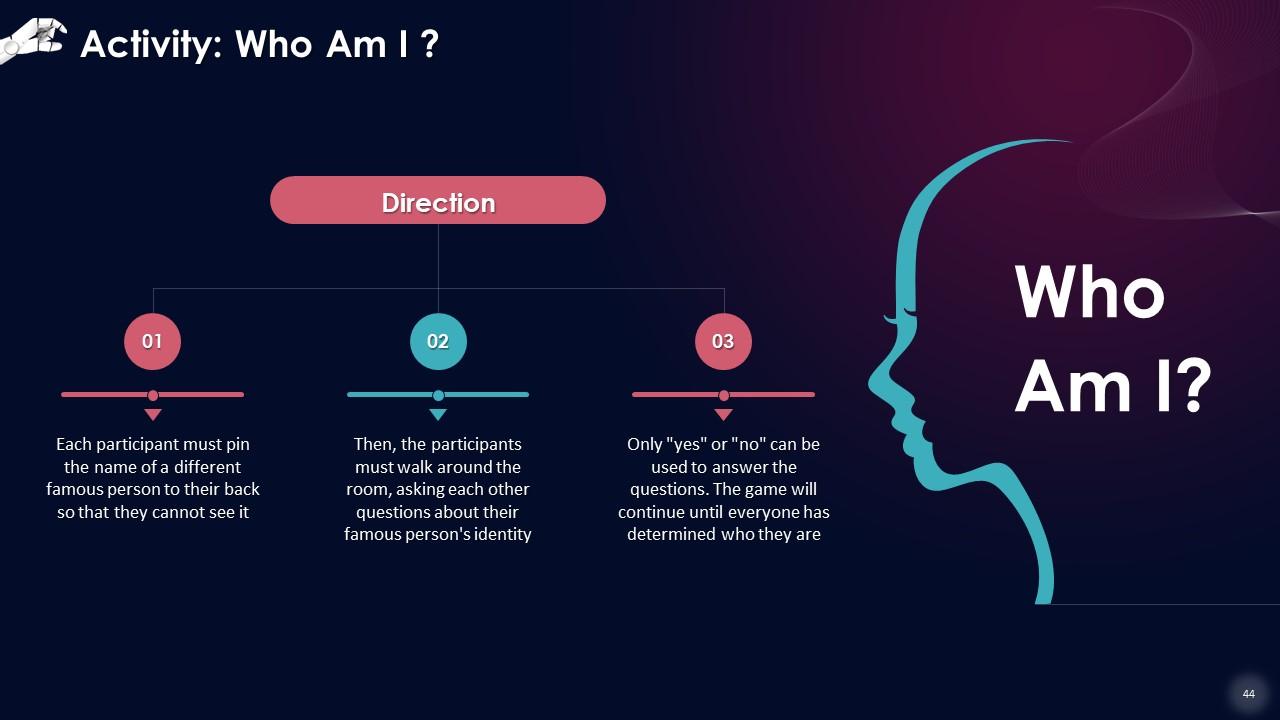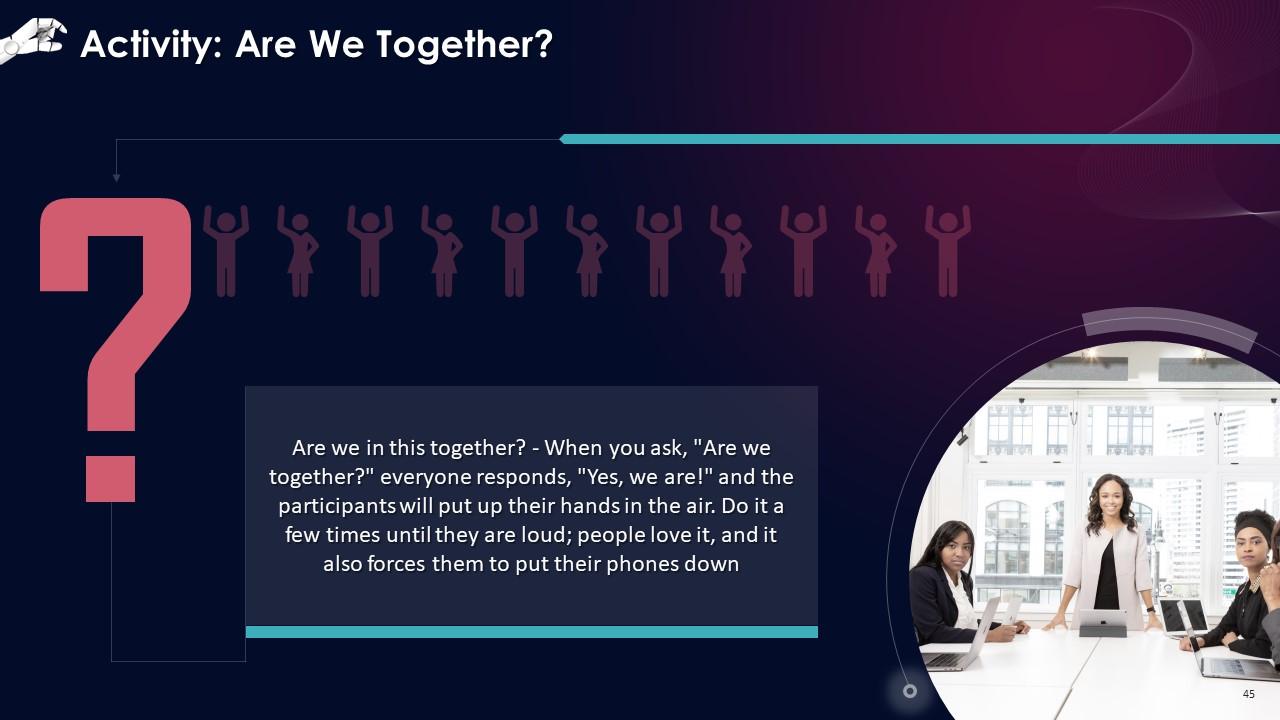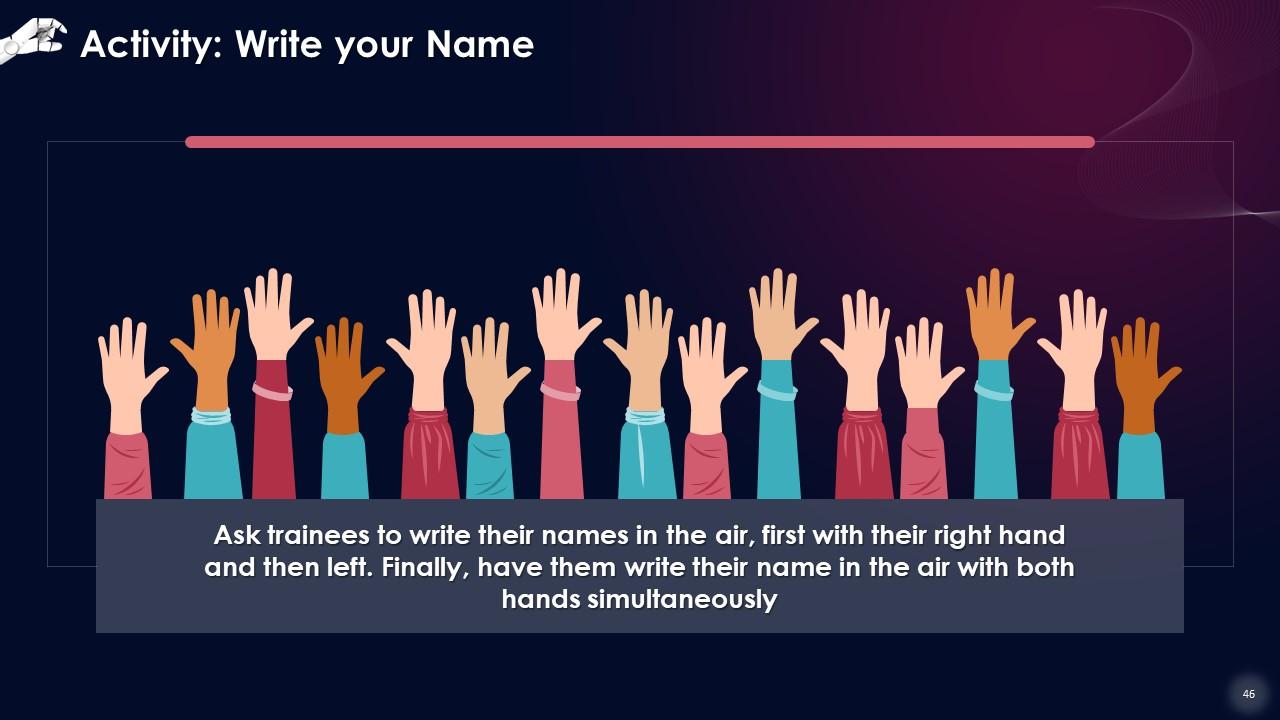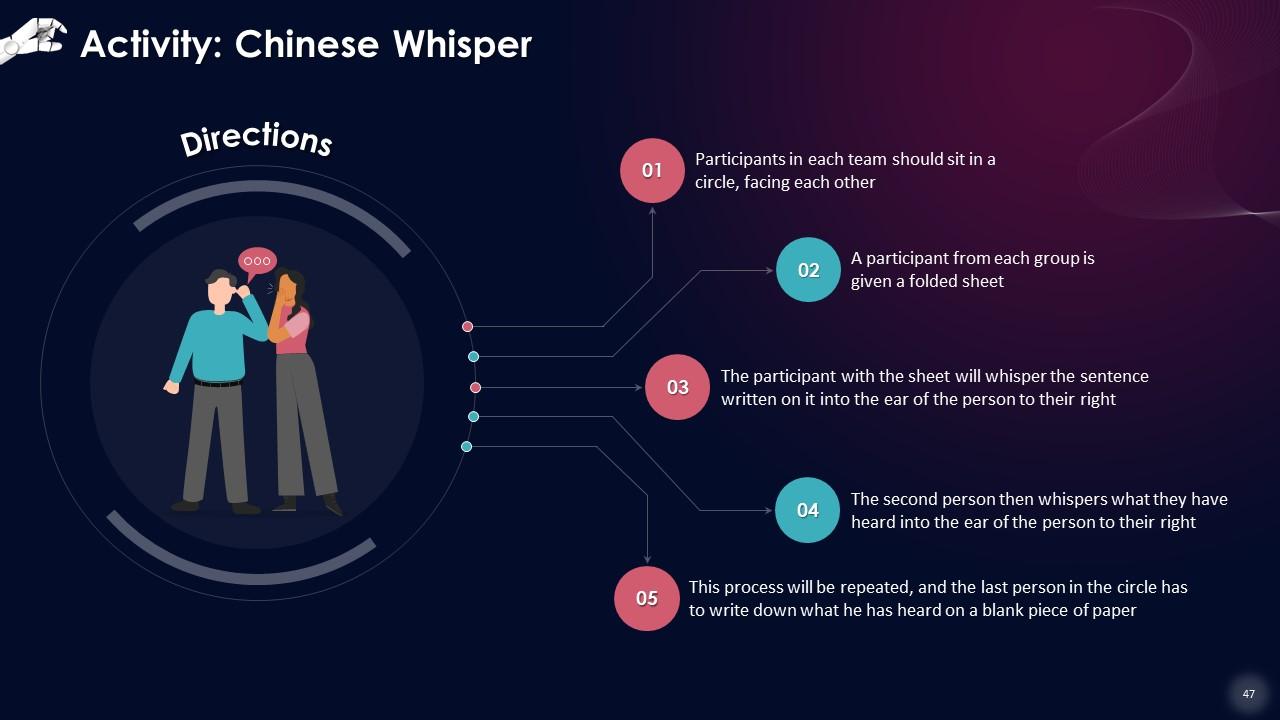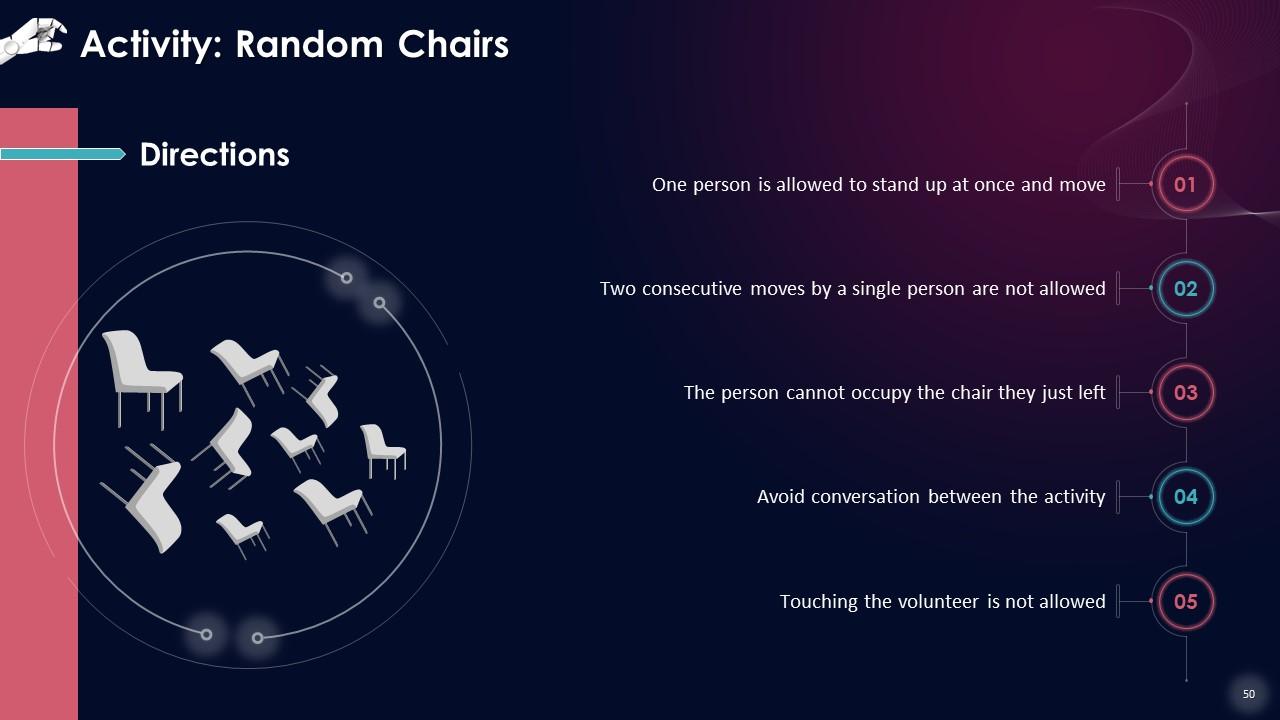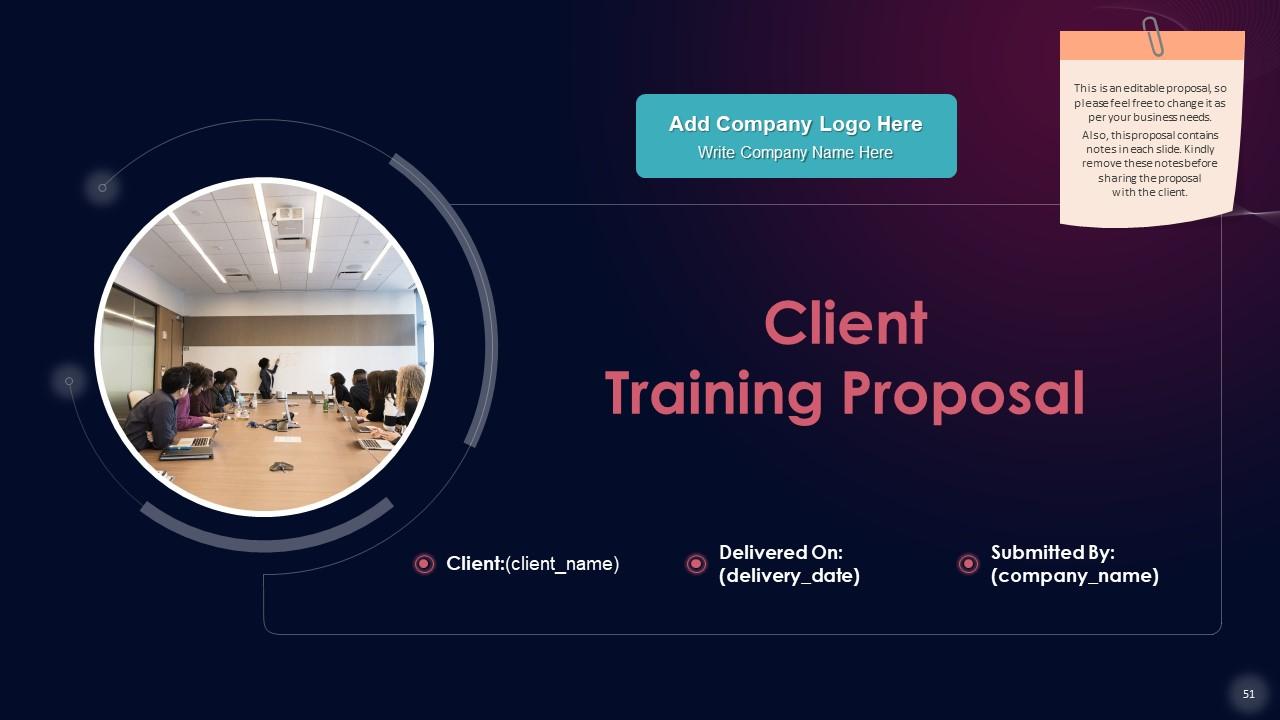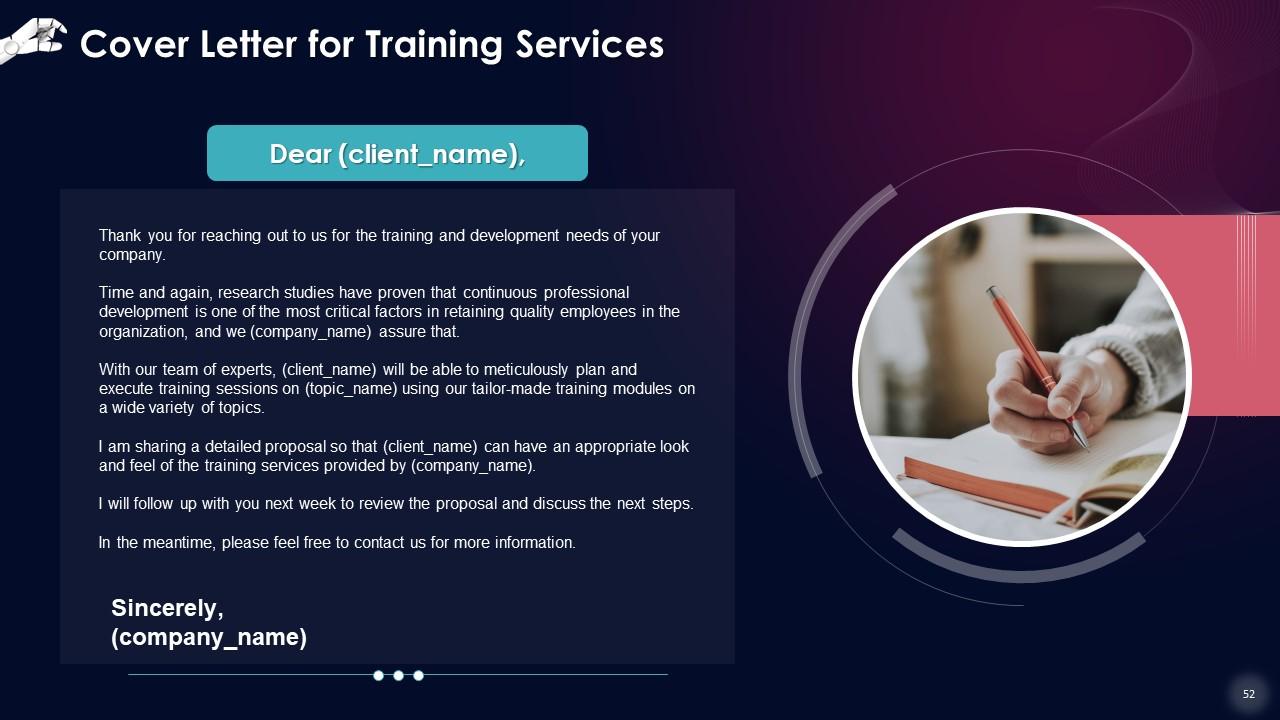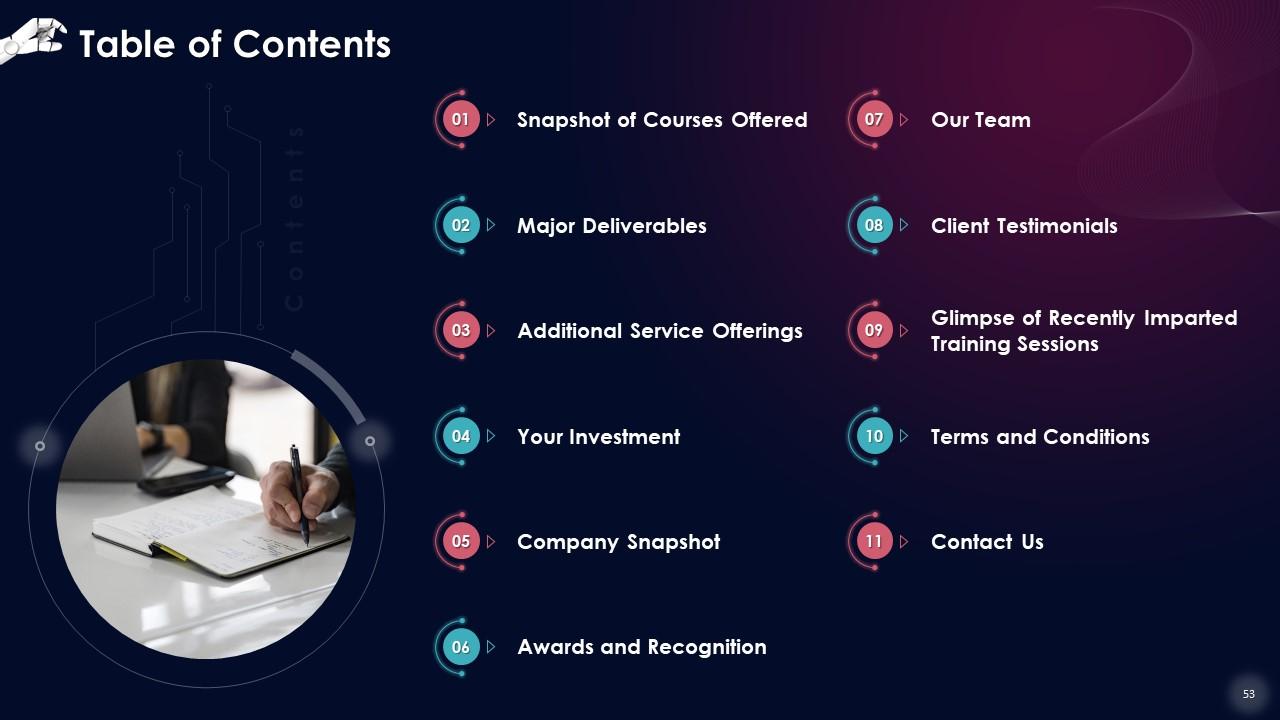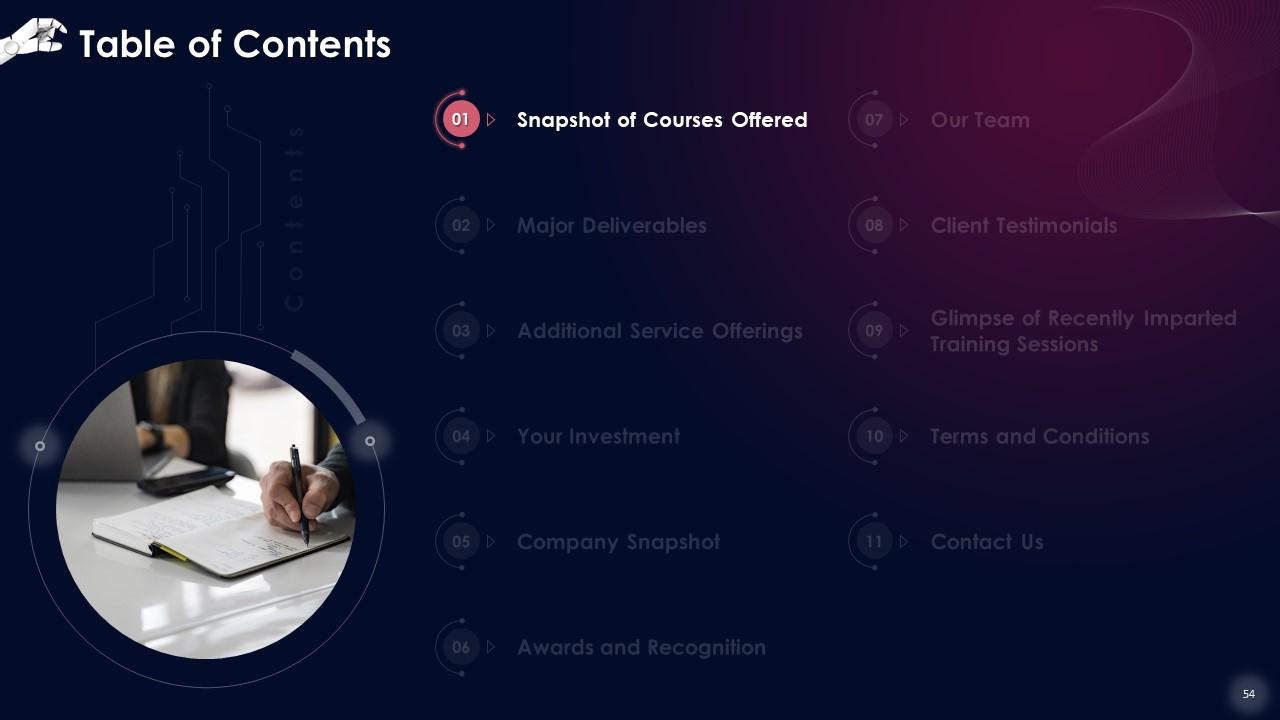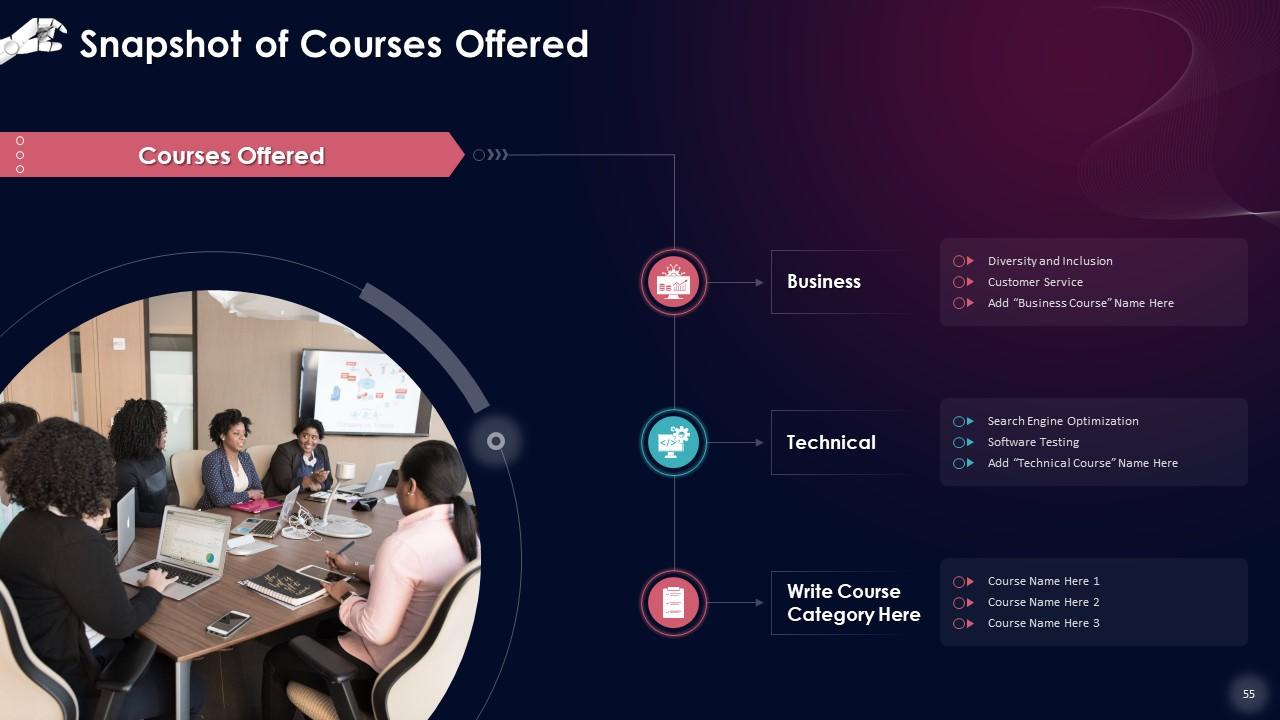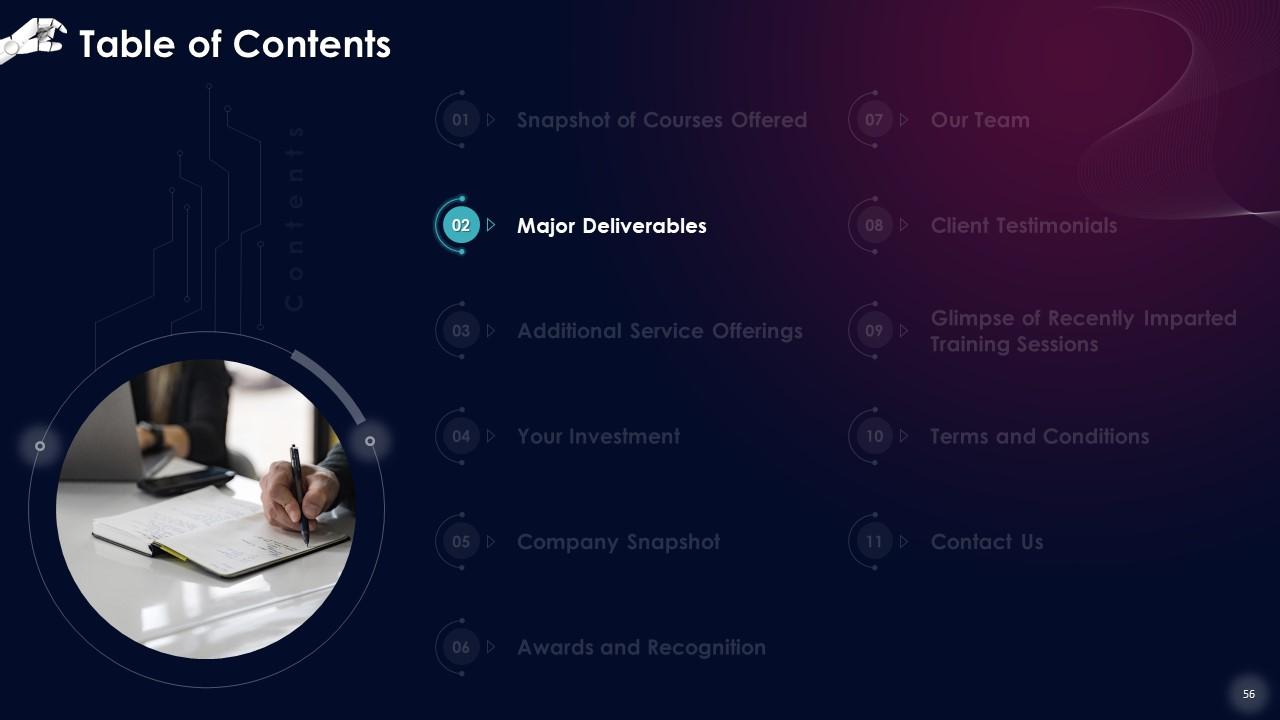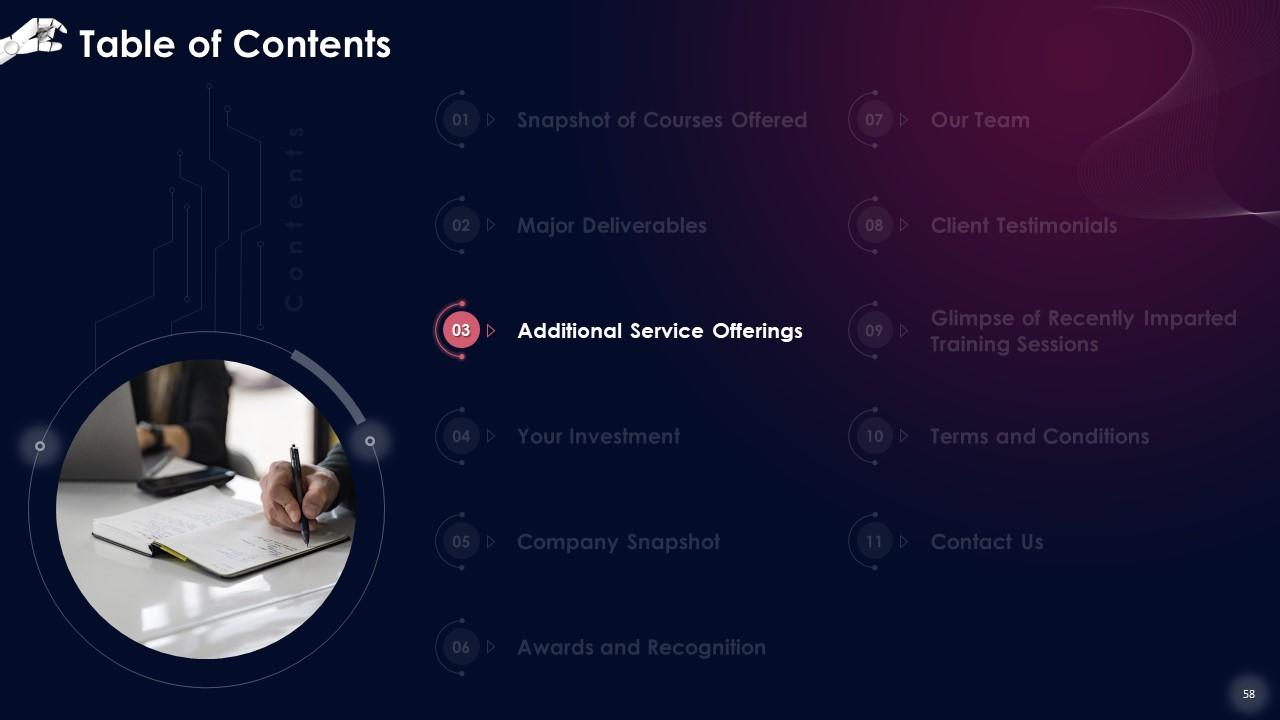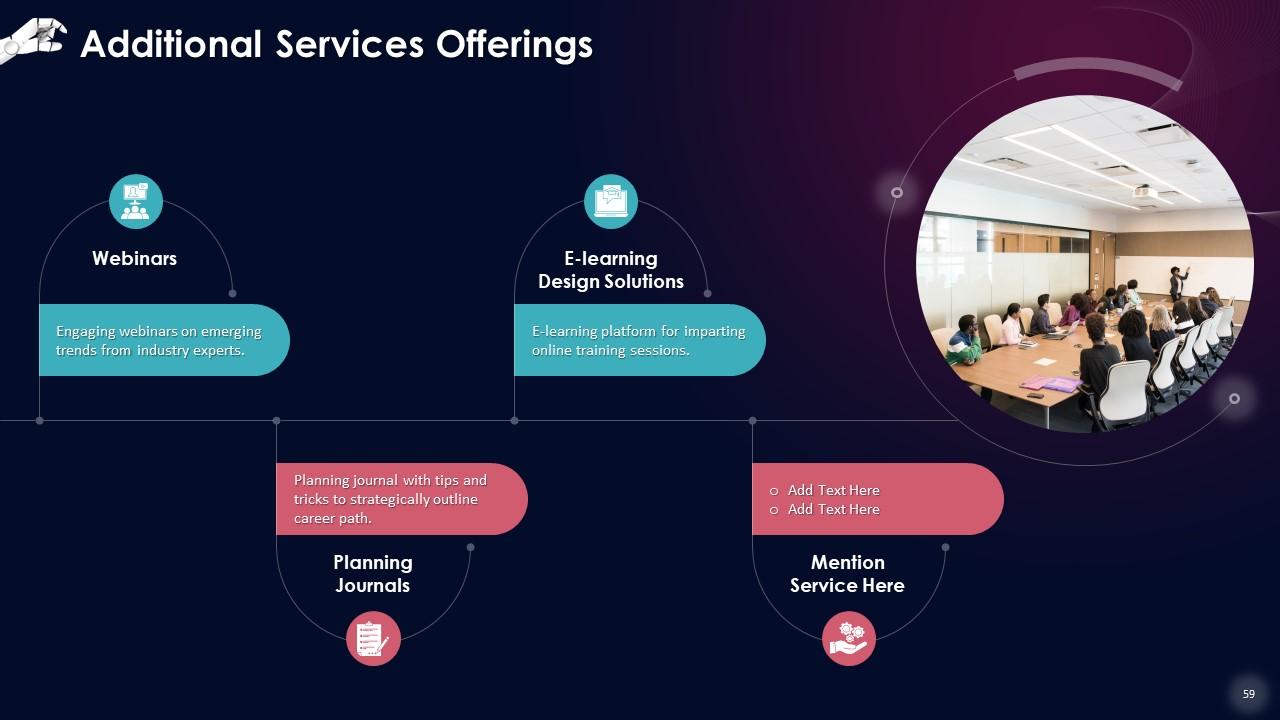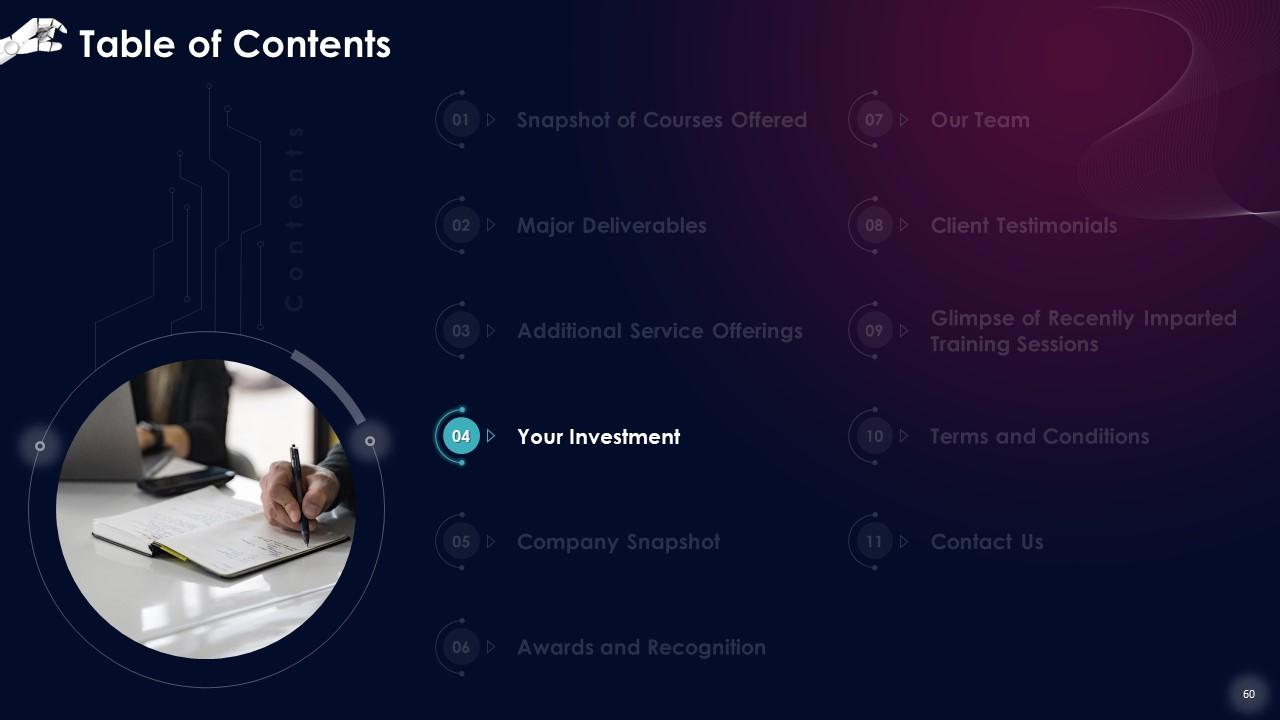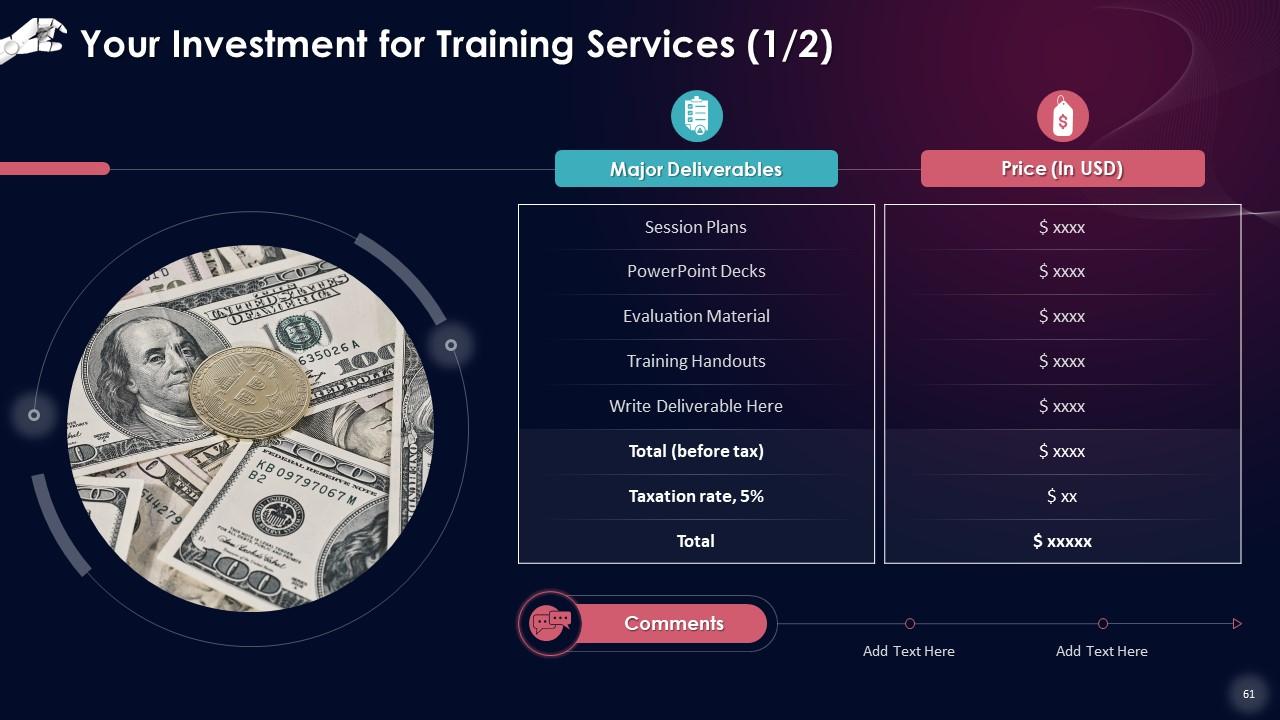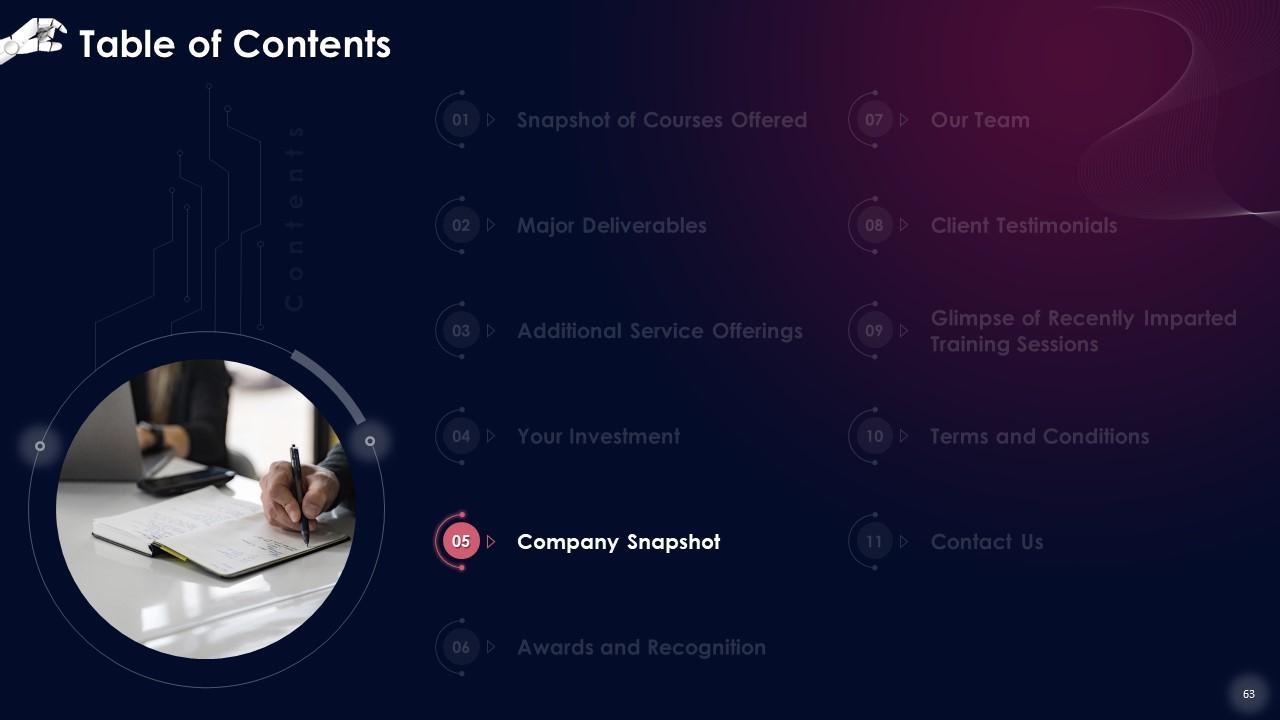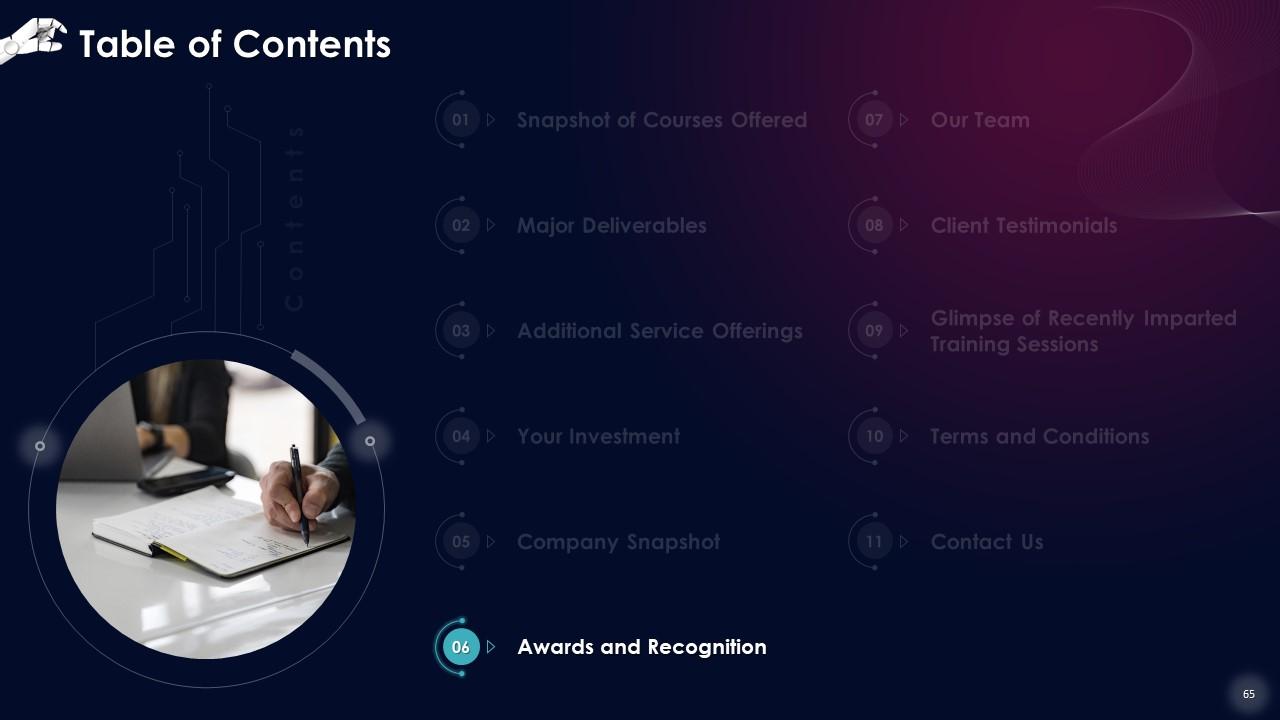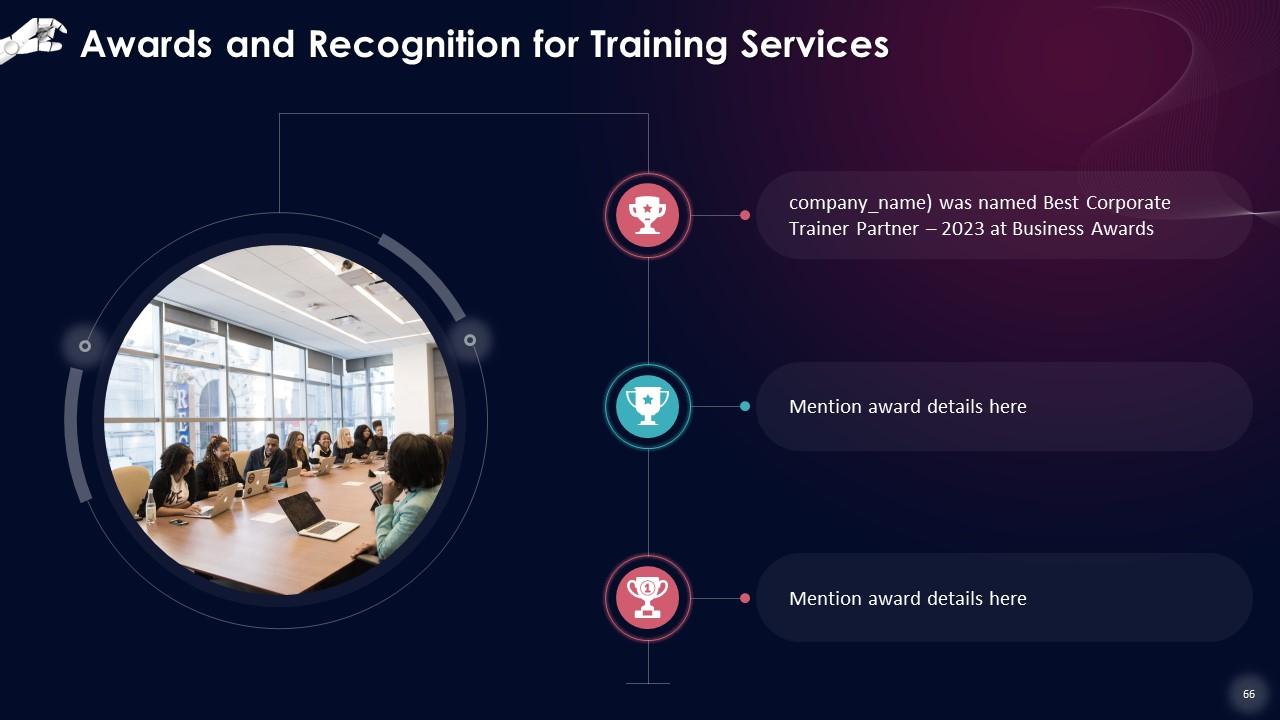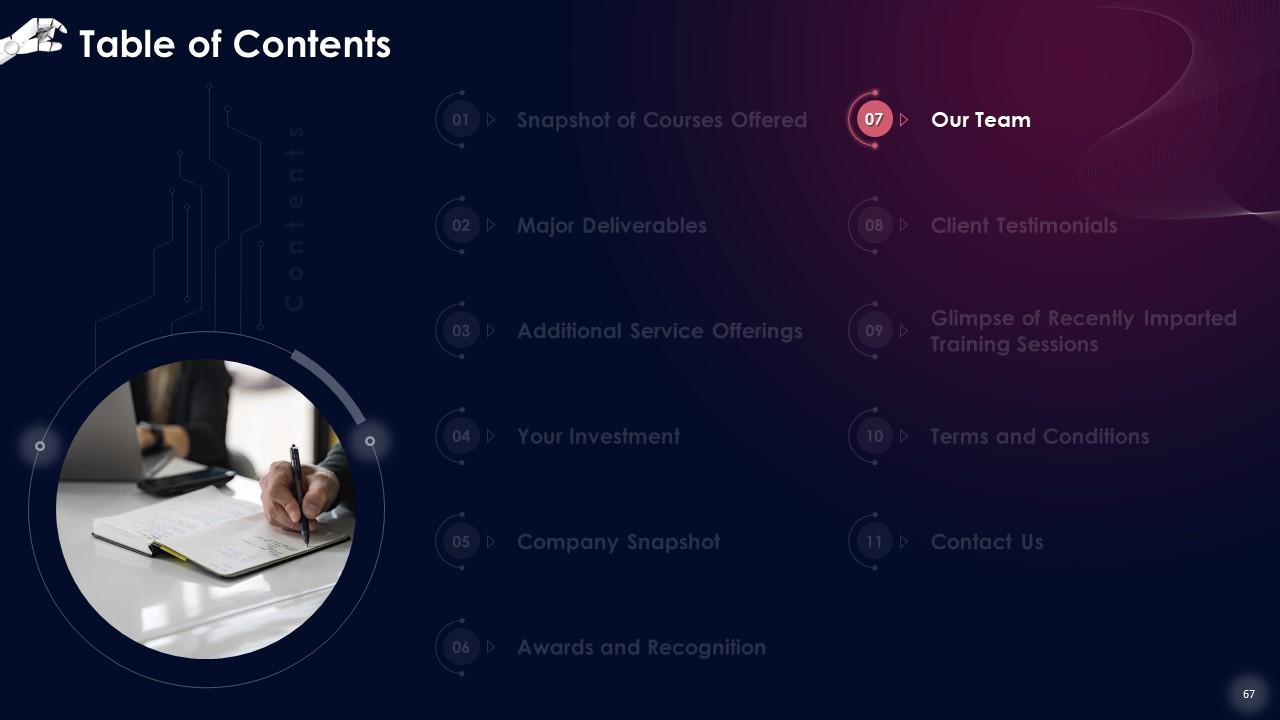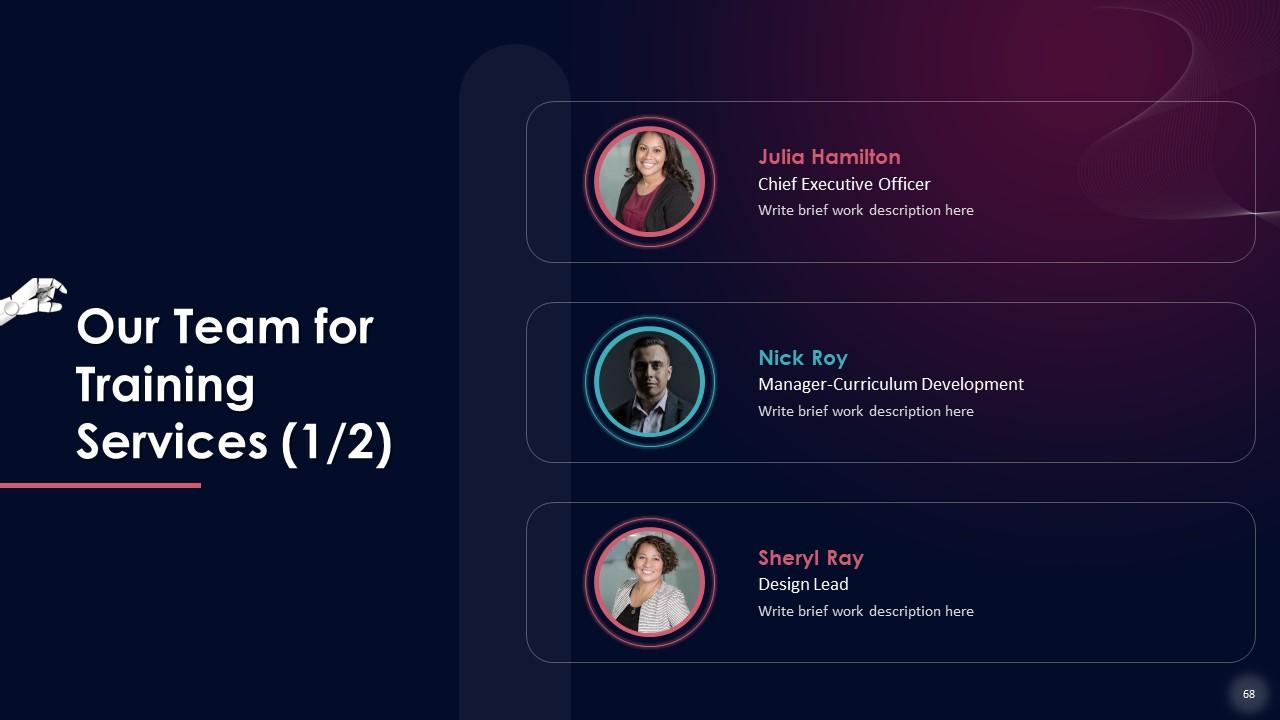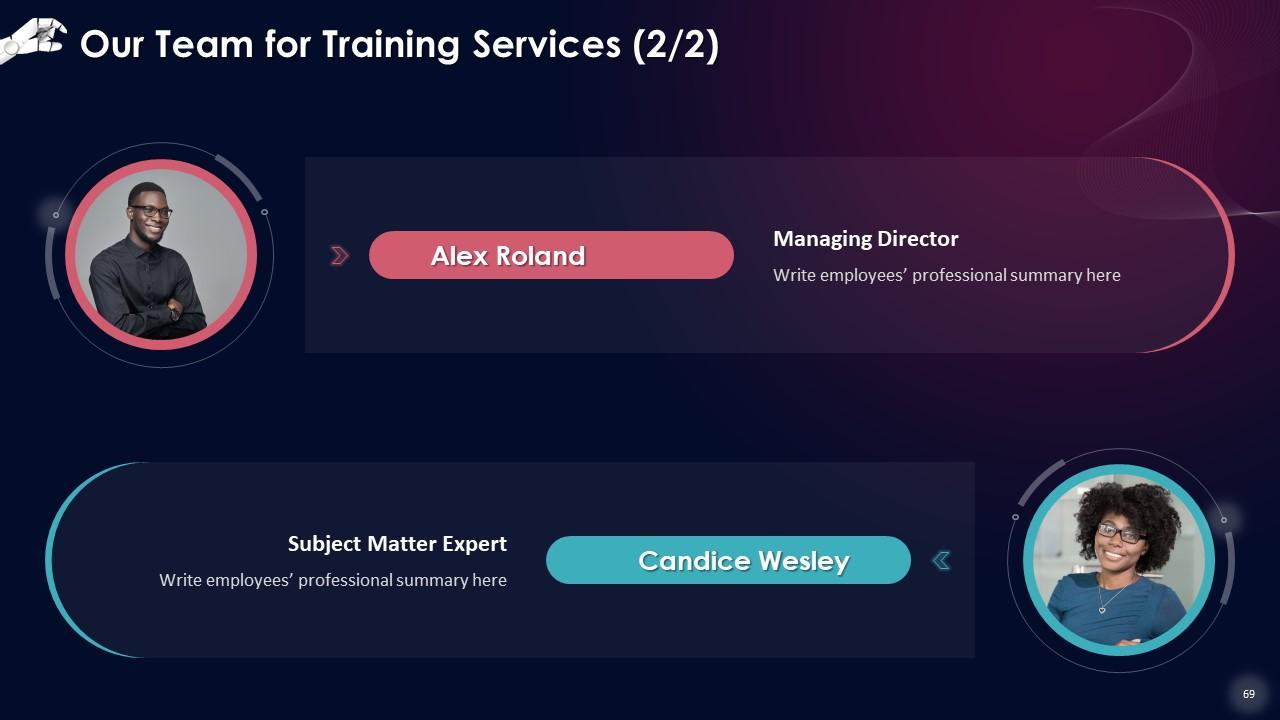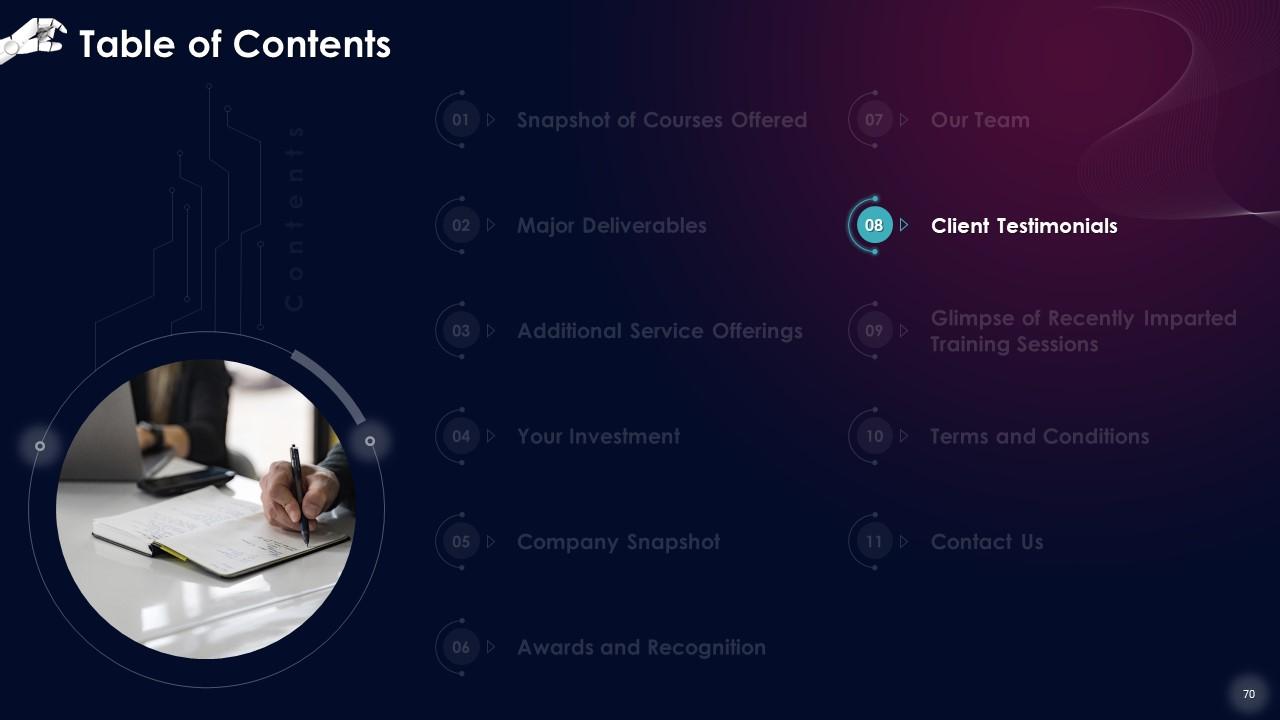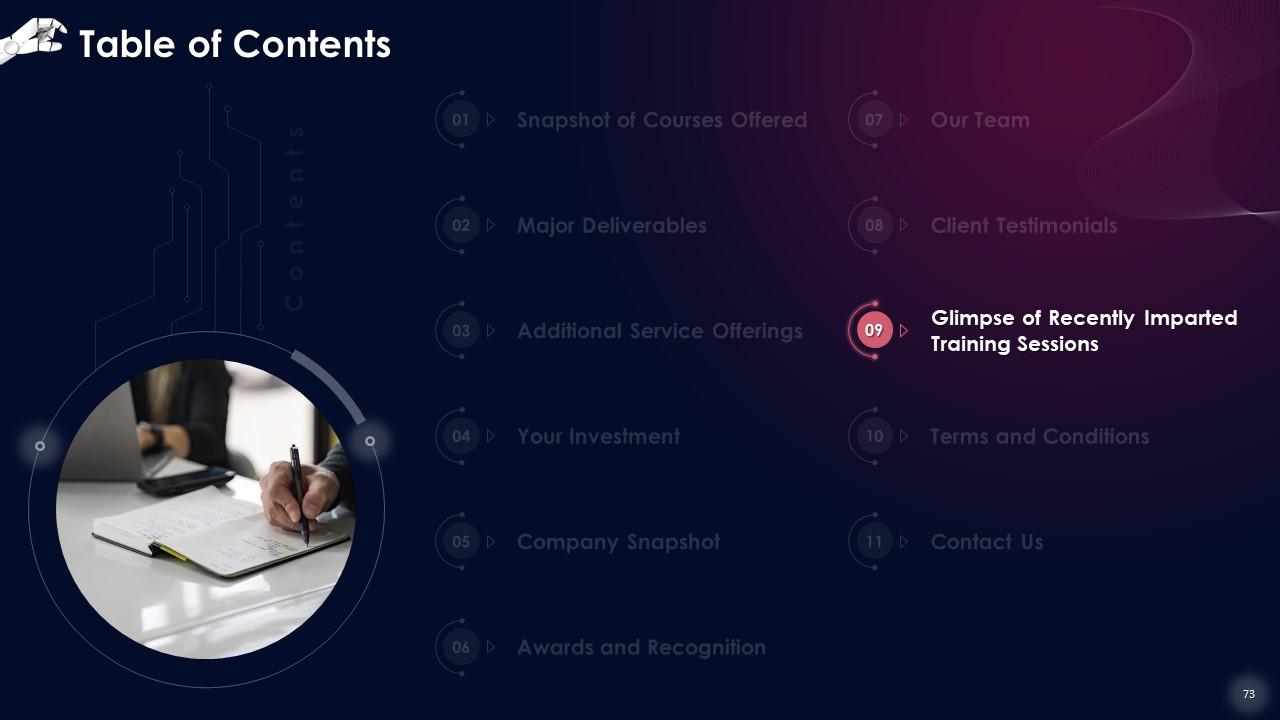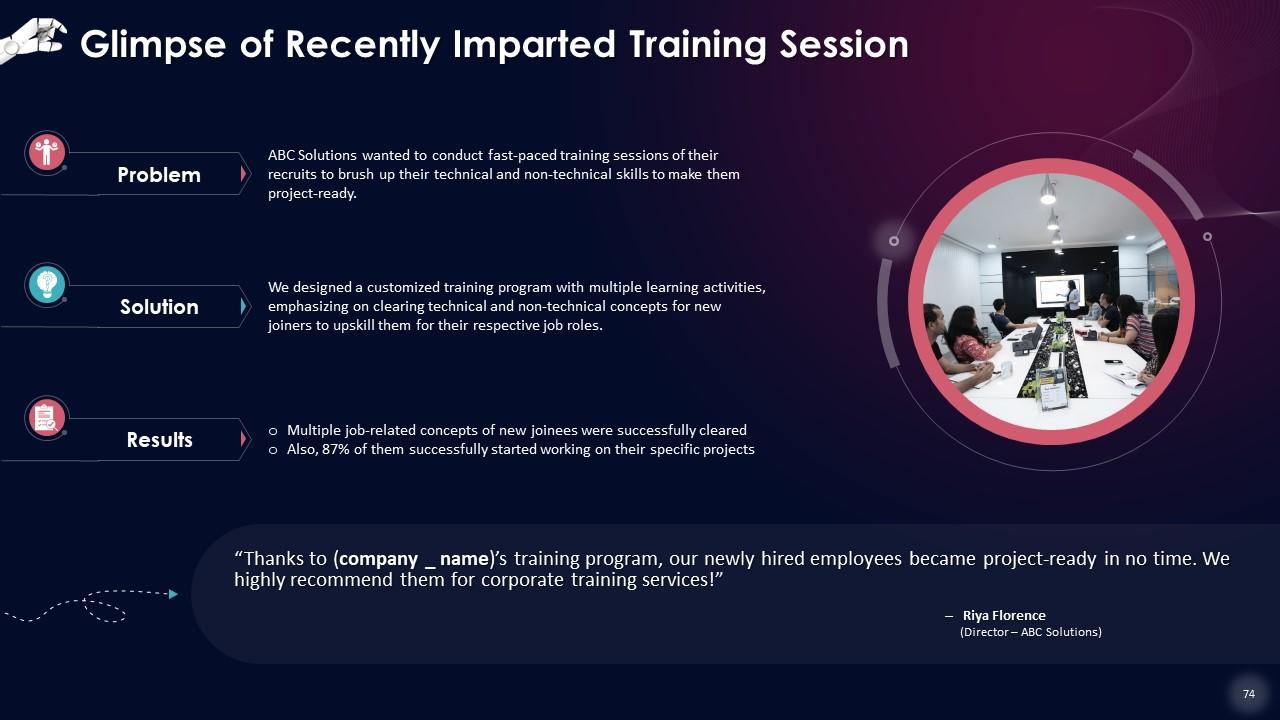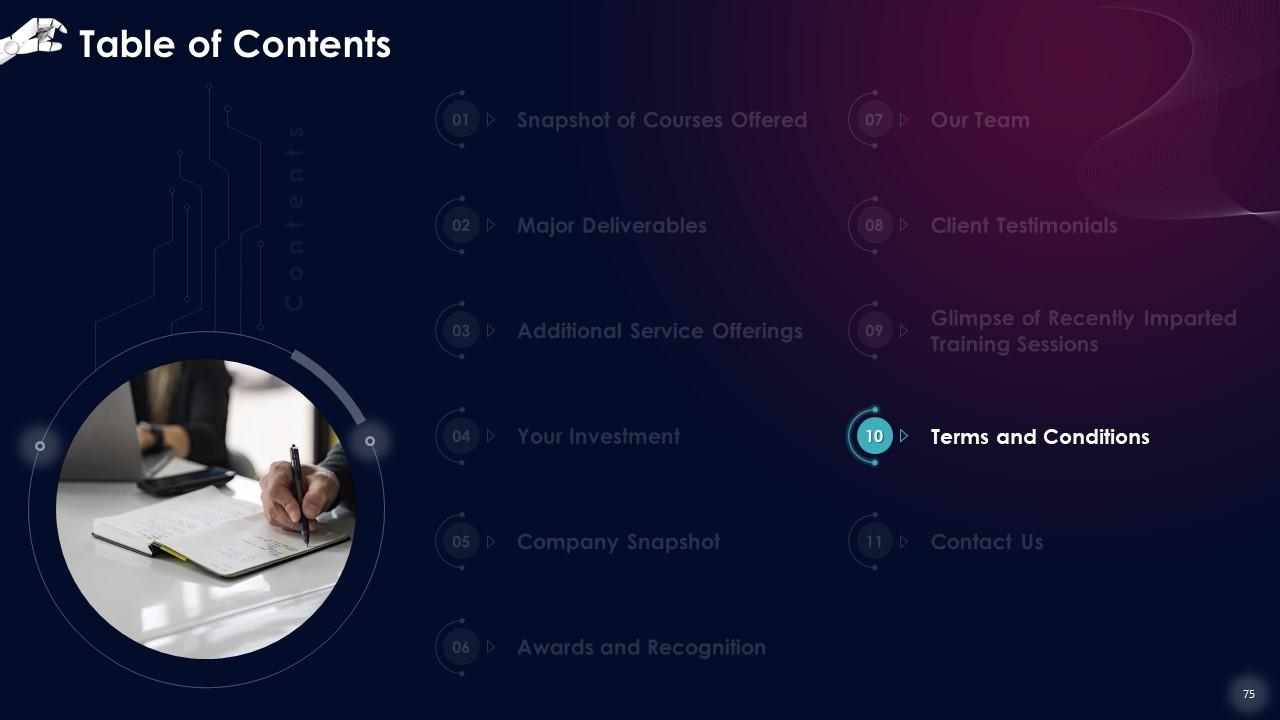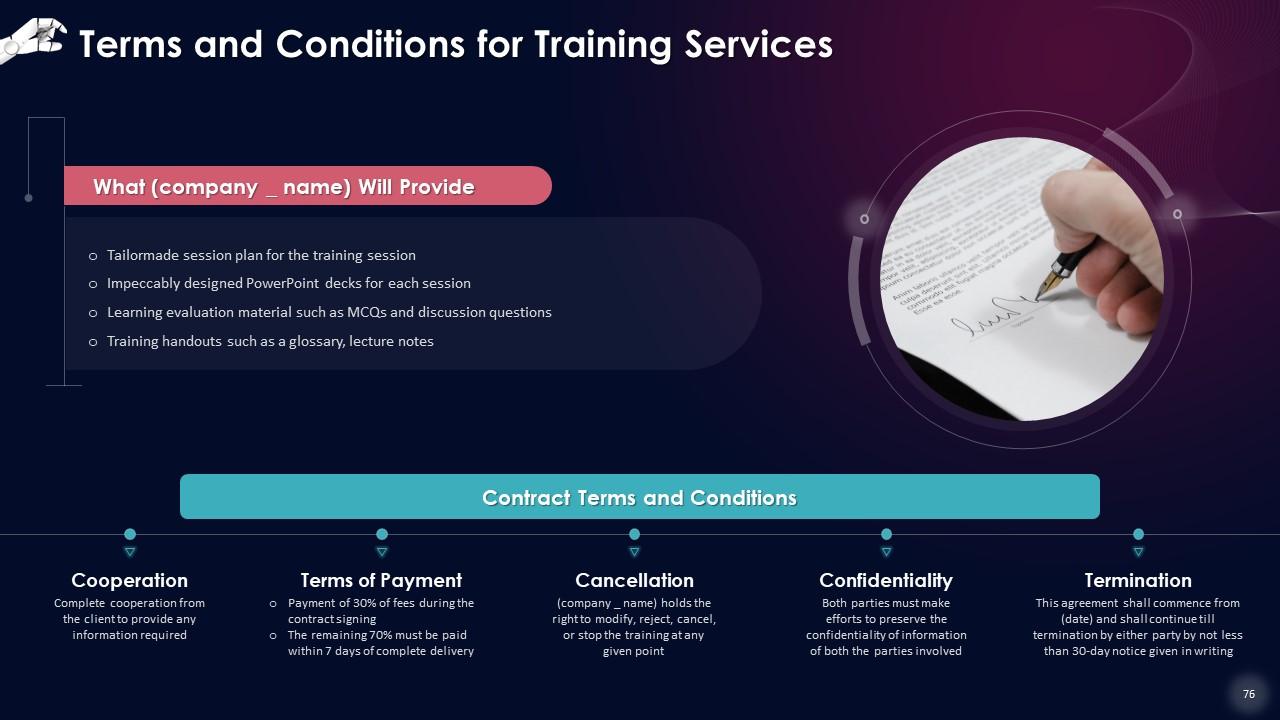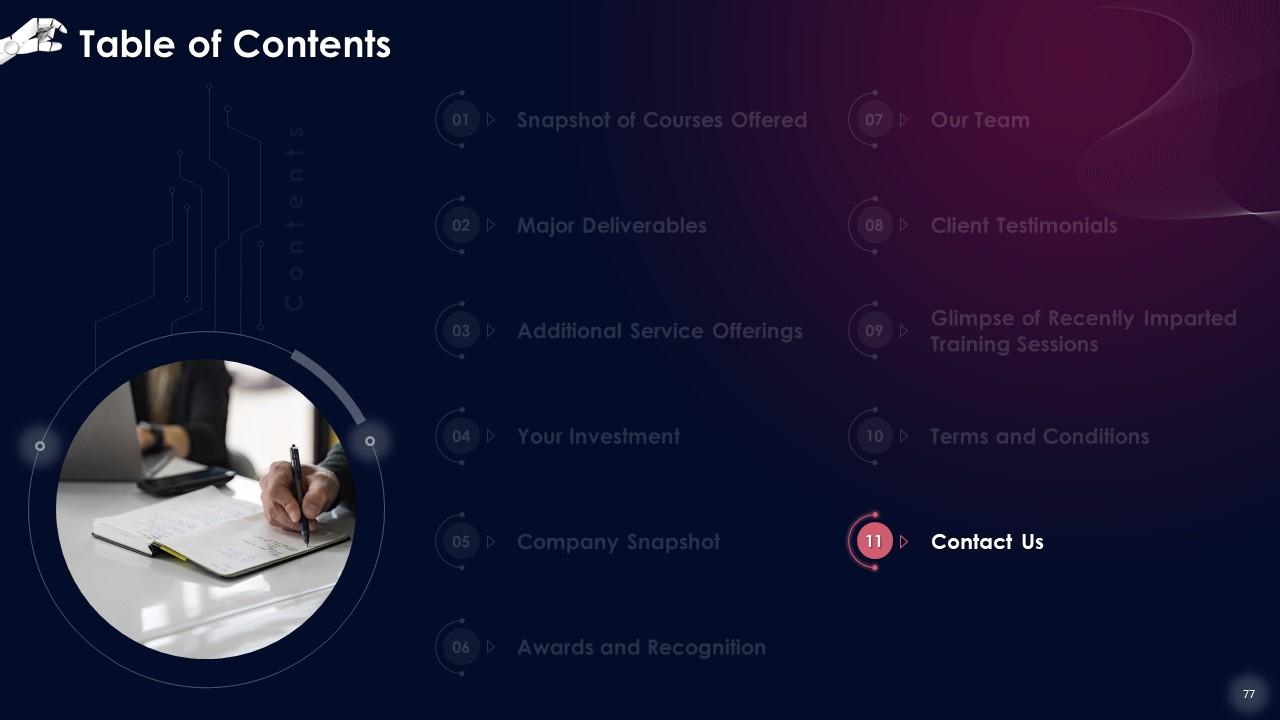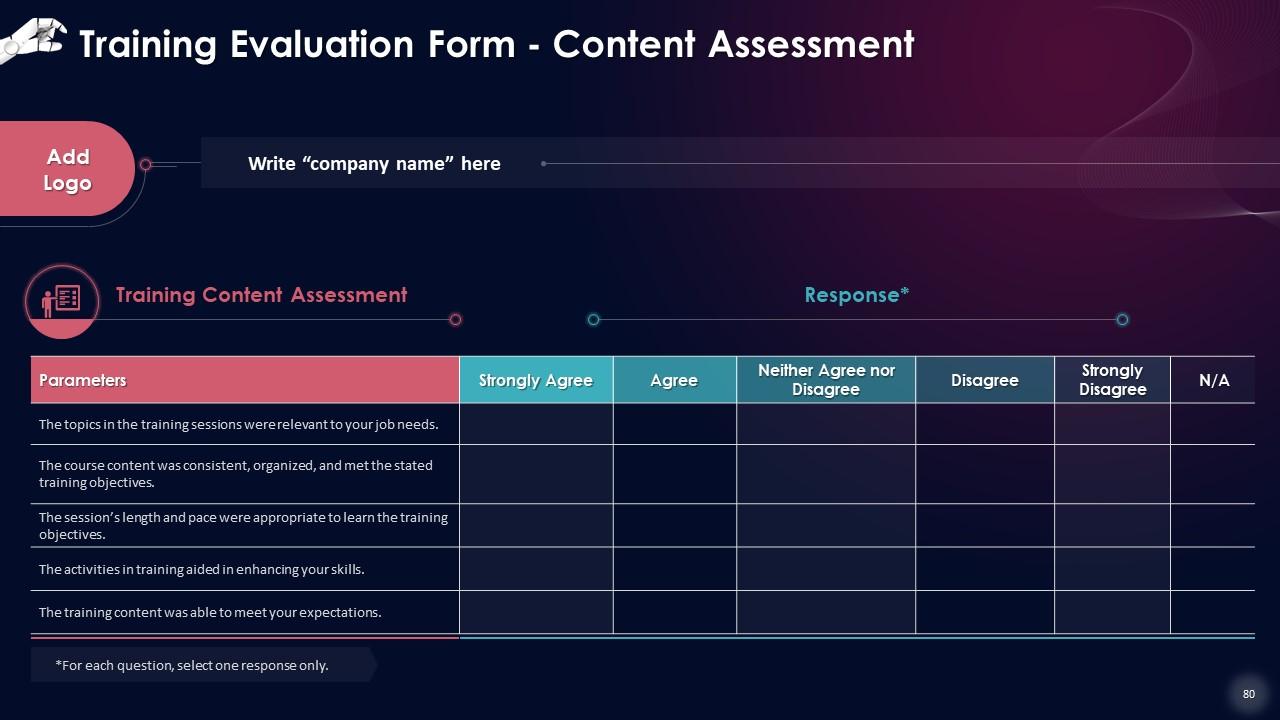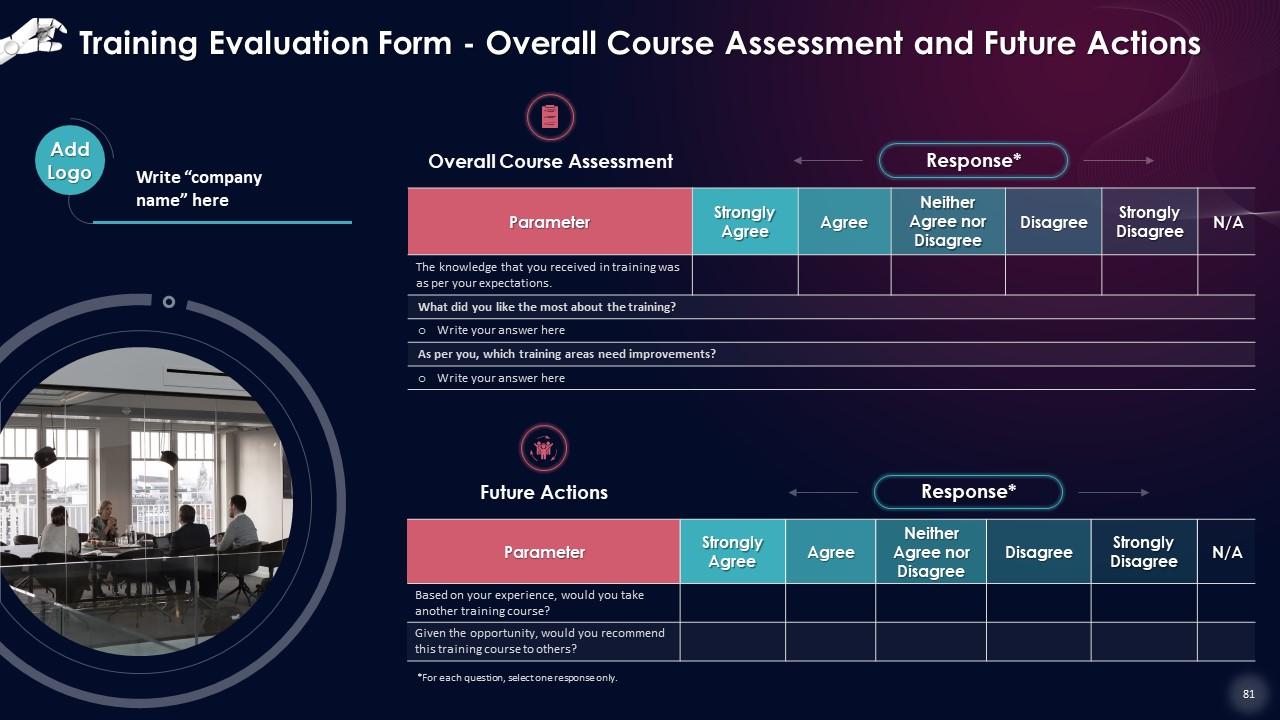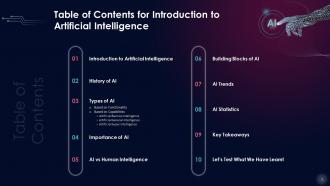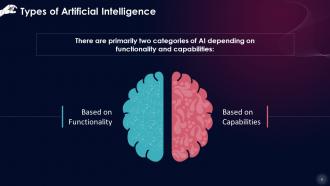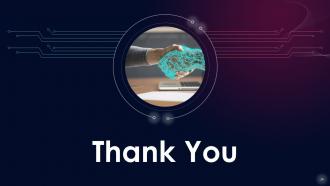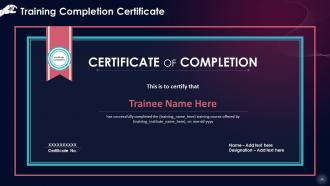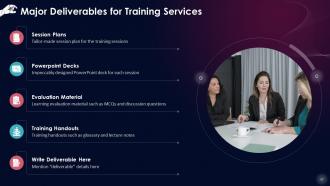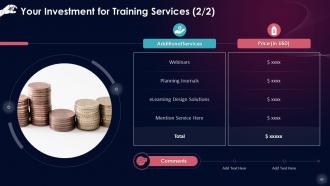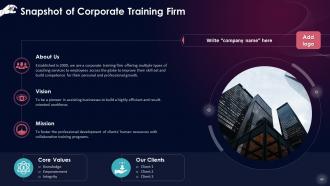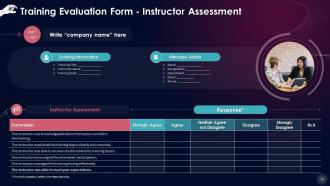A Beginners Guide To Artificial Intelligence Training Ppt
This training module on A Beginners Guide to Artificial Intelligence provides a comprehensive view of the concept of AI. It presents its definition along with its history. Further, it covers its types that are based on functionality Limited Theory, Reactive Machine, Theory of Mind, Self-Aware AI and capabilities Artificial Narrow Intelligence ANI, Artificial General Intelligence AGI, Artificial Super Intelligence ASI. It also discusses the importance of AI, provides a comparison between human and artificial intelligence, briefly covers the building blocks of AI, and highlights key trends and industry statistics. It also includes Key Takeaways and Discussion Questions related to the topic to make the training session more interactive. The deck has PPT slides on About Us, Vision, Mission, Goal, 30-60-90, Days Plan, Timeline, Roadmap, Training Completion Certificate, and Energizer Activities. It also includes a Client Proposal and Assessment Form for training evaluation.
This training module on A Beginners Guide to Artificial Intelligence provides a comprehensive view of the concept of AI. It..
- Google Slides is a new FREE Presentation software from Google.
- All our content is 100% compatible with Google Slides.
- Just download our designs, and upload them to Google Slides and they will work automatically.
- Amaze your audience with SlideTeam and Google Slides.
-
Want Changes to This PPT Slide? Check out our Presentation Design Services
- WideScreen Aspect ratio is becoming a very popular format. When you download this product, the downloaded ZIP will contain this product in both standard and widescreen format.
-

- Some older products that we have may only be in standard format, but they can easily be converted to widescreen.
- To do this, please open the SlideTeam product in Powerpoint, and go to
- Design ( On the top bar) -> Page Setup -> and select "On-screen Show (16:9)” in the drop down for "Slides Sized for".
- The slide or theme will change to widescreen, and all graphics will adjust automatically. You can similarly convert our content to any other desired screen aspect ratio.
Compatible With Google Slides

Get This In WideScreen
You must be logged in to download this presentation.
PowerPoint presentation slides
Presenting Training Deck on A Beginners Guide to Artificial Intelligence. This deck comprises of 81 slides. Each slide is well crafted and designed by our PowerPoint experts. This PPT presentation is thoroughly researched by the experts, and every slide consists of appropriate content. All slides are customizable. You can add or delete the content as per your need. Not just this, you can also make the required changes in the charts and graphs. Download this professionally designed business presentation, add your content, and present it with confidence.
People who downloaded this PowerPoint presentation also viewed the following :
Content of this Powerpoint Presentation
Slide 4
This slide gives an introduction to Artificial Intelligence (AI), which involves embedding intelligence in machines so that these can function like humans. Machines use this AI to make decisions in real-time. An Artificially Intelligent computer receives real-time data, discovers its meaning and responds appropriately.
Slide 5
This slide illustrates the history of Artificial Intelligence. Dartmouth College invented the phrase "Artificial Intelligence" in 1956. AI gained attention in 1980s due to technology advancements that the Japanese made in this field.
Slide 6
This slide lists the types of Artificial Intelligence. There are primarily two categories of AI depending on functionality and capabilities.
Slide 7
This slide illustrates that functional categorization classifies AI based on its resemblance to the human mind and its ability to think and feel like humans. The functional types of AI are:
Instructor Notes:
- Limited Theory: This sort of AI has memory capabilities, allowing it to use prior information/experience to make better future judgments. Most applications that we encounter today, fit into this category. These AI applications may be taught by storing a considerable amount of training data in their memory in a reference model
- Reactive Machines: These are the most basic and ancient form of Artificial Intelligence. These simulate a human's capacity to respond to many types of inputs. Because this sort of AI lacks memory power, it cannot access previously acquired information/experience to get better results
- Theory of mind: With little to no presence in our daily life, this kind of AI is primarily at the "Work in Progress" stage, and is restricted to research labs. Once created, these types of AI will have a thorough understanding of human brains, including their wants, preferences, emotions, mental processes, and so on. The AI will change its response based on its comprehension of the human brain and its whims
- Self-aware AI: It is the last stage in the evolution of AI. Its existence is speculative and can only be discovered in science fiction films. These kinds of AI can comprehend and elicit human emotions and feelings. These types of AI are decades, if not centuries away from becoming a reality. This is the type of AI that sceptics like Elon Musk are concerned about. Once an AI becomes self-aware, it can enter self-preservation mode; it may view humanity as a possible threat and may directly or indirectly pursue efforts to terminate our race
Slide 8
This slide demonstrates that the second categorization method is more common in the IT business, and is based on capabilities of AI against human intelligence.
Instructor Notes:
- ANI is the foremost level of AI that we have achieved to date
- AGI stands for Artificial General Intelligence, sometimes known as human-level AI
- ASI is an Artificial Super Intelligence that is sharper than the world's brightest people's combined intellect in every discipline
Slide 9
This slide depicts that artificial narrow intelligence encompasses an AI system that, like humans, can execute specified particular activities. However, because these robots cannot complete jobs for which they were not previously designed, they fail to perform an ‘unprecedented’ task.
Slide 10
This slide showcases that artificial general intelligence can train, learn, understand, and perform functions as humans do. These systems will have multi-functional capabilities that span disciplines, and these systems will be more agile, reacting and improvising like people in the face of unforeseen events.
Slide 11
This slide illustrates that Artificial Super Intelligence (AI) will be the most powerful kind of intelligence ever to exist on Earth. It far-improved data processing, memory, and decision-making abilities will mean that it will be better than humans in all tasks. Some experts are concerned that the introduction of ASI will lead to Technological Singularity.
Instructor Notes:
Technological Singularity: It is a speculative scenario in which technological advancement reaches an uncontrollable point, leading to unimaginable changes in human civilization.
Slide 12
This slide discusses what makes Artificial Intelligence so important and useful. These benefits include automation, enhancement, analysis, accuracy, and ROI.
Instructor’s Notes:
- Automation: AI can automate a routine process previously completed by hand, without causing weariness or the need for breaks that a human employee requires
- Enhancement: Through skills such as optimizing conversation bots or customer service menus and giving better product suggestions, AI can make products and services better and more effective, enhancing end-user experience
- Analysis: AI can process data far quicker than people, detecting patterns much faster. It can also examine much bigger datasets than humans, revealing patterns that humans might miss
- Accuracy: AI can be trained to be more accurate than humans in jobs such as choosing financial investments or recognizing malignant growths (on x-rays) by exploiting its capacity to acquire and evaluate data
- ROI: AI increases the quality of data by better evaluating complicated, multivariate connections without taking pauses and with fewer errors. This makes it a critical technology for any company that depends on data and works at scale
Slide 13
This slide lists the differences between Artificial Intelligence and human intelligence. The parameters for comparison are multitasking, decision making, time efficiency, and state.
Slide 15
This slide displays the AI system's building components, such as input, processing and storage (edge), processing and storage (cloud), and output/interaction unit.
Instructor Notes:
- Input: Captures data from users and the immediate environment through mobile applications, cameras, microphones, and so on
- Processing and storage (Edge Computing): Processing and storage are essential and need to happen, even if the Internet is not available. In the event that updates do not happen, the system should be self-sufficient, and decisions should be made on the run
- Processing and storage (Cloud): It comprises collection of data in even more detail. Machine learning model creation and maintenance happen in this stage. Data scientists get involved in the AI process from this layer onwards
- Unit of output/interaction: Output might be in the form of a display/voice or a robotic activity
Slide 16
This slide explores sectors in which AI can be seen as a business opportunity such as cloud adoption, cyber security, IoT etc.
Instructor’s Notes:
- AI and Cloud Adoption: Artificial intelligence and cloud computing have produced solutions that benefit millions. AI, speech recognition, and cloud computing are now part of our daily lives thanks to digital assistants like Siri, Google Home, and Amazon's Alexa. AI-based capabilities are now layered on top of cloud computing, assisting businesses in managing data, delivering consumer experiences, and streamlining operations
- Voice and Language driven AI: Developers can now use speech technologies, chatbots, and increasingly AI-enabled voice to train neural network models and create human-like experiences. Natural Language Processing (NLP) and Natural Language Generation (NLG) enable computers to comprehend, interpret, and modify the human language, allowing us to communicate with machines
- AI and Cyber Security: AI has emerged as a critical technology in data security because of its ability to automate large-scale processes, access millions of events, and identify a wide range of threats – from malware to identifying risky behavior that could lead to a phishing attack or the download of malicious content
- AI and Customer Service Digitization: A firm cannot succeed without monitoring and enhancing customer experience, regardless of its exceptional service or product. A company's most crucial building component is its customers. Brands continue to use AI to generate real interactions and the hyper-personalized experience to satisfy changing customer expectations
- AI for Digital Business Automation: Several firms have turned to Robotic Process Automation (RPA) as a digital transformation hack. RPA is cheaper and faster than total platform revamps, and it minimizes reliance on humans for high-volume, repetitive operations. Continued AI and Machine Learning advancements enhance RPA's ability to handle more complex jobs in cognitive automation, such as pattern recognition and decision-making
- AI for IoT: Smart gadgets like Google Nest, Smart Plugs, and Smart Locks now only respond to commands, but when combined with AI technology, these devices can foresee human requirements and start appliances and processes without human participation
Slide 17
This slide demonstrates the Global Artificial Intelligence Market share in 2021. The global AI market was worth $93.5 billion in 2021, and it is expected to increase at a 38.1% Compound Annual Growth Rate (CAGR) from 2022 to 2030. The adoption of advanced technologies in finance, automotive, healthcare, retail, and manufacturing is driven by continual research and innovation.
Slide 18
This slide demonstrates the statistics in adoption of Artificial Intelligence. Majority of the leading businesses in the US have invested in AI technologies to increase their economic gains and many businesses believe that AI will disrupt their business practices.
Slide 19
This slide mentions important AI Statistics. In this digital age, smart, data-driven technologies like Artificial Intelligence are being used at an unprecedented scale in enterprise applications, reshaping the business landscape like never before.
Slide 35 to 50
These slides contain energizer activities to engage the audience of the training session.
Slide 51 to 78
These slides contain a training proposal covering what the company providing corporate training can accomplish for the client.
Slide 79 to 81
These slides include a training evaluation form for instructor, content and course assessment.
A Beginners Guide To Artificial Intelligence Training Ppt with all 86 slides:
Use our A Beginners Guide To Artificial Intelligence Training Ppt to effectively help you save your valuable time. They are readymade to fit into any presentation structure.
-
Good research work and creative work done on every template.
-
Definitely recommend SlideTeam to all who need help with PowerPoint presentations. Their design team can create anything you need.


